Substance Use Disorder Among College Students: Signs, Symptoms, and Classification of Drugs
VerifiedAdded on 2022/11/13
|29
|9431
|422
AI Summary
This chapter provides a comprehensive literature review on substance use disorder among college students, including signs, symptoms, and classification of drugs. It also covers DSM-5 criteria, types of treatment, college recovery community, positive psychology, and comparative mythology.
Contribute Materials
Your contribution can guide someone’s learning journey. Share your
documents today.
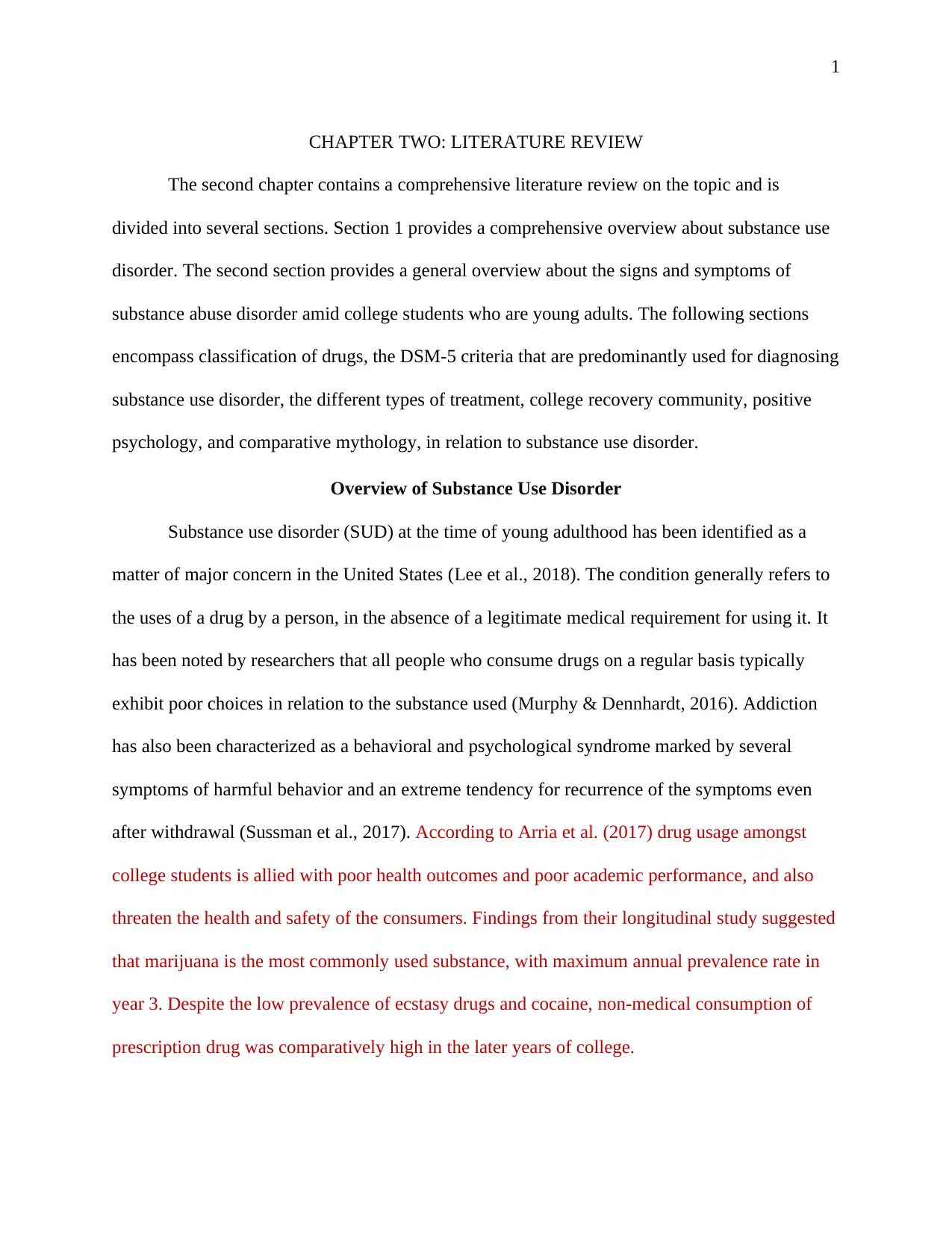
1
CHAPTER TWO: LITERATURE REVIEW
The second chapter contains a comprehensive literature review on the topic and is
divided into several sections. Section 1 provides a comprehensive overview about substance use
disorder. The second section provides a general overview about the signs and symptoms of
substance abuse disorder amid college students who are young adults. The following sections
encompass classification of drugs, the DSM-5 criteria that are predominantly used for diagnosing
substance use disorder, the different types of treatment, college recovery community, positive
psychology, and comparative mythology, in relation to substance use disorder.
Overview of Substance Use Disorder
Substance use disorder (SUD) at the time of young adulthood has been identified as a
matter of major concern in the United States (Lee et al., 2018). The condition generally refers to
the uses of a drug by a person, in the absence of a legitimate medical requirement for using it. It
has been noted by researchers that all people who consume drugs on a regular basis typically
exhibit poor choices in relation to the substance used (Murphy & Dennhardt, 2016). Addiction
has also been characterized as a behavioral and psychological syndrome marked by several
symptoms of harmful behavior and an extreme tendency for recurrence of the symptoms even
after withdrawal (Sussman et al., 2017). According to Arria et al. (2017) drug usage amongst
college students is allied with poor health outcomes and poor academic performance, and also
threaten the health and safety of the consumers. Findings from their longitudinal study suggested
that marijuana is the most commonly used substance, with maximum annual prevalence rate in
year 3. Despite the low prevalence of ecstasy drugs and cocaine, non-medical consumption of
prescription drug was comparatively high in the later years of college.
CHAPTER TWO: LITERATURE REVIEW
The second chapter contains a comprehensive literature review on the topic and is
divided into several sections. Section 1 provides a comprehensive overview about substance use
disorder. The second section provides a general overview about the signs and symptoms of
substance abuse disorder amid college students who are young adults. The following sections
encompass classification of drugs, the DSM-5 criteria that are predominantly used for diagnosing
substance use disorder, the different types of treatment, college recovery community, positive
psychology, and comparative mythology, in relation to substance use disorder.
Overview of Substance Use Disorder
Substance use disorder (SUD) at the time of young adulthood has been identified as a
matter of major concern in the United States (Lee et al., 2018). The condition generally refers to
the uses of a drug by a person, in the absence of a legitimate medical requirement for using it. It
has been noted by researchers that all people who consume drugs on a regular basis typically
exhibit poor choices in relation to the substance used (Murphy & Dennhardt, 2016). Addiction
has also been characterized as a behavioral and psychological syndrome marked by several
symptoms of harmful behavior and an extreme tendency for recurrence of the symptoms even
after withdrawal (Sussman et al., 2017). According to Arria et al. (2017) drug usage amongst
college students is allied with poor health outcomes and poor academic performance, and also
threaten the health and safety of the consumers. Findings from their longitudinal study suggested
that marijuana is the most commonly used substance, with maximum annual prevalence rate in
year 3. Despite the low prevalence of ecstasy drugs and cocaine, non-medical consumption of
prescription drug was comparatively high in the later years of college.
Secure Best Marks with AI Grader
Need help grading? Try our AI Grader for instant feedback on your assignments.
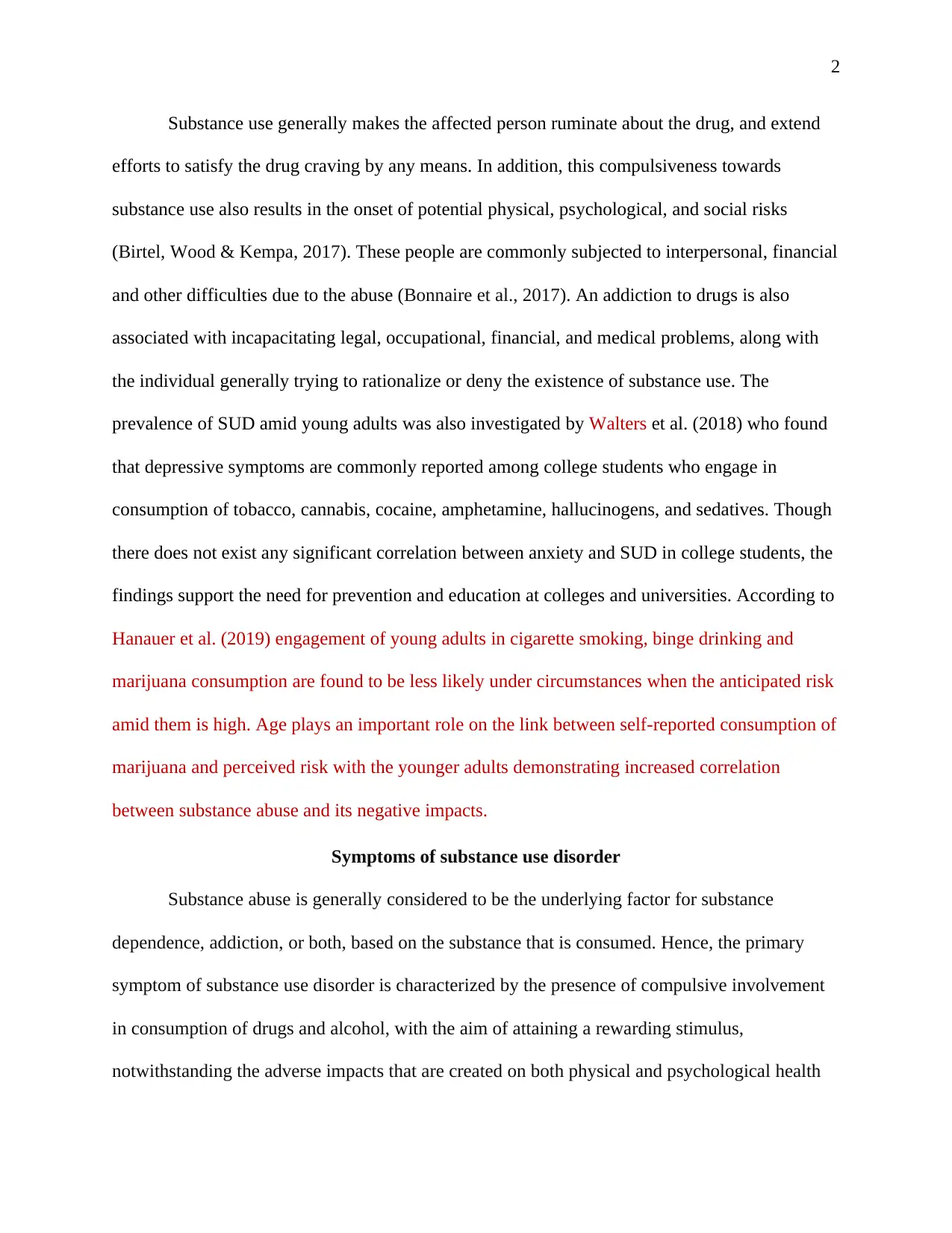
2
Substance use generally makes the affected person ruminate about the drug, and extend
efforts to satisfy the drug craving by any means. In addition, this compulsiveness towards
substance use also results in the onset of potential physical, psychological, and social risks
(Birtel, Wood & Kempa, 2017). These people are commonly subjected to interpersonal, financial
and other difficulties due to the abuse (Bonnaire et al., 2017). An addiction to drugs is also
associated with incapacitating legal, occupational, financial, and medical problems, along with
the individual generally trying to rationalize or deny the existence of substance use. The
prevalence of SUD amid young adults was also investigated by Walters et al. (2018) who found
that depressive symptoms are commonly reported among college students who engage in
consumption of tobacco, cannabis, cocaine, amphetamine, hallucinogens, and sedatives. Though
there does not exist any significant correlation between anxiety and SUD in college students, the
findings support the need for prevention and education at colleges and universities. According to
Hanauer et al. (2019) engagement of young adults in cigarette smoking, binge drinking and
marijuana consumption are found to be less likely under circumstances when the anticipated risk
amid them is high. Age plays an important role on the link between self-reported consumption of
marijuana and perceived risk with the younger adults demonstrating increased correlation
between substance abuse and its negative impacts.
Symptoms of substance use disorder
Substance abuse is generally considered to be the underlying factor for substance
dependence, addiction, or both, based on the substance that is consumed. Hence, the primary
symptom of substance use disorder is characterized by the presence of compulsive involvement
in consumption of drugs and alcohol, with the aim of attaining a rewarding stimulus,
notwithstanding the adverse impacts that are created on both physical and psychological health
Substance use generally makes the affected person ruminate about the drug, and extend
efforts to satisfy the drug craving by any means. In addition, this compulsiveness towards
substance use also results in the onset of potential physical, psychological, and social risks
(Birtel, Wood & Kempa, 2017). These people are commonly subjected to interpersonal, financial
and other difficulties due to the abuse (Bonnaire et al., 2017). An addiction to drugs is also
associated with incapacitating legal, occupational, financial, and medical problems, along with
the individual generally trying to rationalize or deny the existence of substance use. The
prevalence of SUD amid young adults was also investigated by Walters et al. (2018) who found
that depressive symptoms are commonly reported among college students who engage in
consumption of tobacco, cannabis, cocaine, amphetamine, hallucinogens, and sedatives. Though
there does not exist any significant correlation between anxiety and SUD in college students, the
findings support the need for prevention and education at colleges and universities. According to
Hanauer et al. (2019) engagement of young adults in cigarette smoking, binge drinking and
marijuana consumption are found to be less likely under circumstances when the anticipated risk
amid them is high. Age plays an important role on the link between self-reported consumption of
marijuana and perceived risk with the younger adults demonstrating increased correlation
between substance abuse and its negative impacts.
Symptoms of substance use disorder
Substance abuse is generally considered to be the underlying factor for substance
dependence, addiction, or both, based on the substance that is consumed. Hence, the primary
symptom of substance use disorder is characterized by the presence of compulsive involvement
in consumption of drugs and alcohol, with the aim of attaining a rewarding stimulus,
notwithstanding the adverse impacts that are created on both physical and psychological health
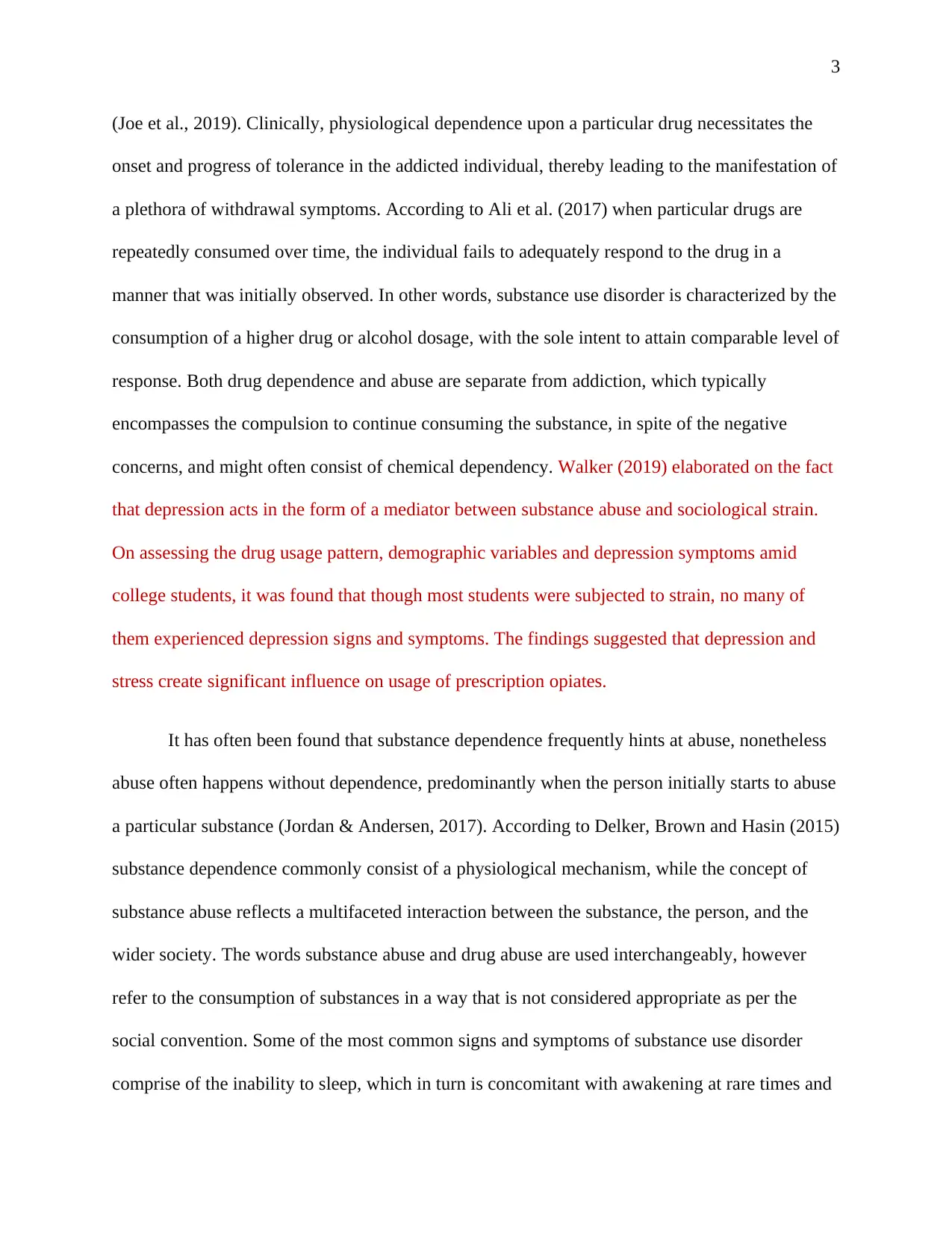
3
(Joe et al., 2019). Clinically, physiological dependence upon a particular drug necessitates the
onset and progress of tolerance in the addicted individual, thereby leading to the manifestation of
a plethora of withdrawal symptoms. According to Ali et al. (2017) when particular drugs are
repeatedly consumed over time, the individual fails to adequately respond to the drug in a
manner that was initially observed. In other words, substance use disorder is characterized by the
consumption of a higher drug or alcohol dosage, with the sole intent to attain comparable level of
response. Both drug dependence and abuse are separate from addiction, which typically
encompasses the compulsion to continue consuming the substance, in spite of the negative
concerns, and might often consist of chemical dependency. Walker (2019) elaborated on the fact
that depression acts in the form of a mediator between substance abuse and sociological strain.
On assessing the drug usage pattern, demographic variables and depression symptoms amid
college students, it was found that though most students were subjected to strain, no many of
them experienced depression signs and symptoms. The findings suggested that depression and
stress create significant influence on usage of prescription opiates.
It has often been found that substance dependence frequently hints at abuse, nonetheless
abuse often happens without dependence, predominantly when the person initially starts to abuse
a particular substance (Jordan & Andersen, 2017). According to Delker, Brown and Hasin (2015)
substance dependence commonly consist of a physiological mechanism, while the concept of
substance abuse reflects a multifaceted interaction between the substance, the person, and the
wider society. The words substance abuse and drug abuse are used interchangeably, however
refer to the consumption of substances in a way that is not considered appropriate as per the
social convention. Some of the most common signs and symptoms of substance use disorder
comprise of the inability to sleep, which in turn is concomitant with awakening at rare times and
(Joe et al., 2019). Clinically, physiological dependence upon a particular drug necessitates the
onset and progress of tolerance in the addicted individual, thereby leading to the manifestation of
a plethora of withdrawal symptoms. According to Ali et al. (2017) when particular drugs are
repeatedly consumed over time, the individual fails to adequately respond to the drug in a
manner that was initially observed. In other words, substance use disorder is characterized by the
consumption of a higher drug or alcohol dosage, with the sole intent to attain comparable level of
response. Both drug dependence and abuse are separate from addiction, which typically
encompasses the compulsion to continue consuming the substance, in spite of the negative
concerns, and might often consist of chemical dependency. Walker (2019) elaborated on the fact
that depression acts in the form of a mediator between substance abuse and sociological strain.
On assessing the drug usage pattern, demographic variables and depression symptoms amid
college students, it was found that though most students were subjected to strain, no many of
them experienced depression signs and symptoms. The findings suggested that depression and
stress create significant influence on usage of prescription opiates.
It has often been found that substance dependence frequently hints at abuse, nonetheless
abuse often happens without dependence, predominantly when the person initially starts to abuse
a particular substance (Jordan & Andersen, 2017). According to Delker, Brown and Hasin (2015)
substance dependence commonly consist of a physiological mechanism, while the concept of
substance abuse reflects a multifaceted interaction between the substance, the person, and the
wider society. The words substance abuse and drug abuse are used interchangeably, however
refer to the consumption of substances in a way that is not considered appropriate as per the
social convention. Some of the most common signs and symptoms of substance use disorder
comprise of the inability to sleep, which in turn is concomitant with awakening at rare times and
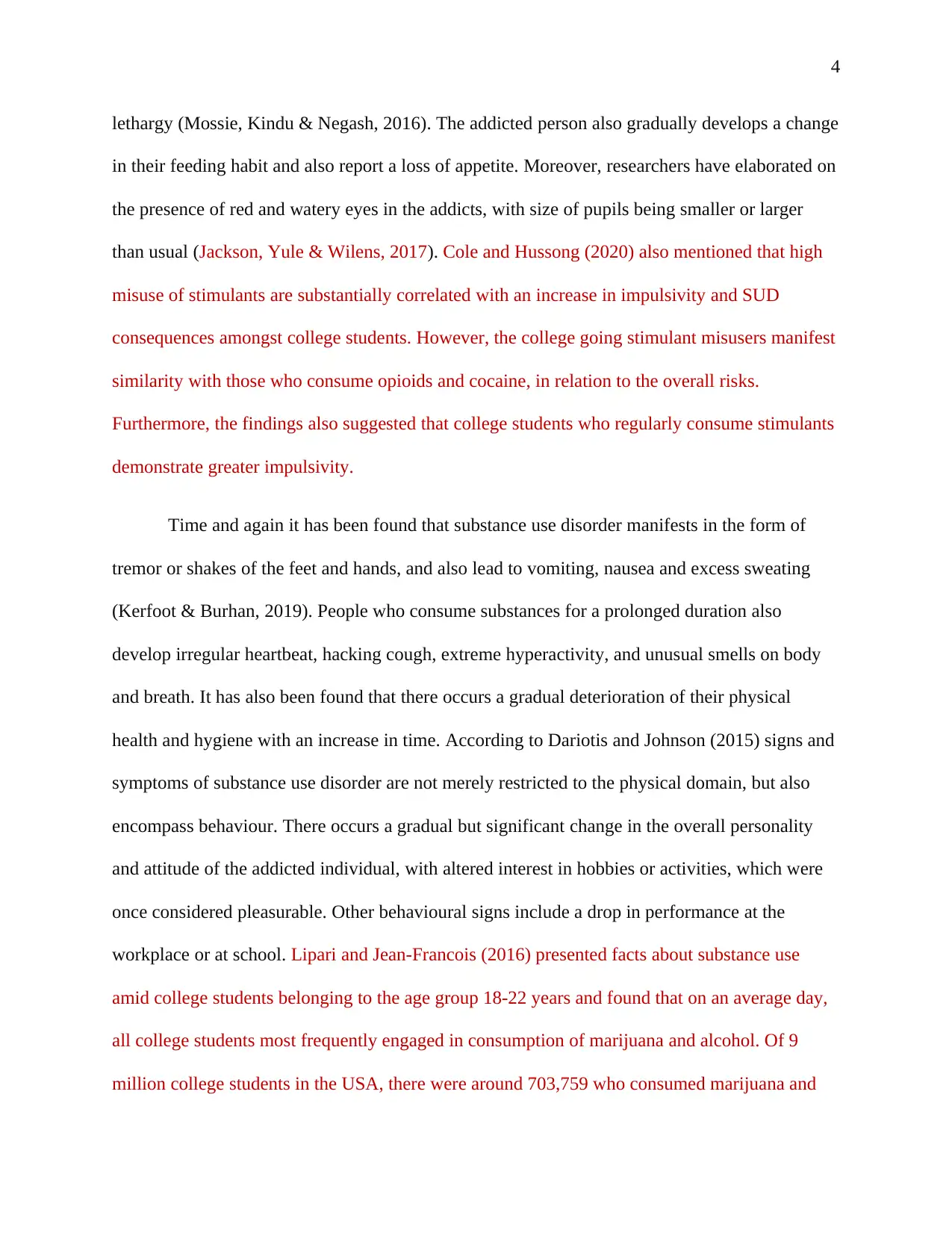
4
lethargy (Mossie, Kindu & Negash, 2016). The addicted person also gradually develops a change
in their feeding habit and also report a loss of appetite. Moreover, researchers have elaborated on
the presence of red and watery eyes in the addicts, with size of pupils being smaller or larger
than usual (Jackson, Yule & Wilens, 2017). Cole and Hussong (2020) also mentioned that high
misuse of stimulants are substantially correlated with an increase in impulsivity and SUD
consequences amongst college students. However, the college going stimulant misusers manifest
similarity with those who consume opioids and cocaine, in relation to the overall risks.
Furthermore, the findings also suggested that college students who regularly consume stimulants
demonstrate greater impulsivity.
Time and again it has been found that substance use disorder manifests in the form of
tremor or shakes of the feet and hands, and also lead to vomiting, nausea and excess sweating
(Kerfoot & Burhan, 2019). People who consume substances for a prolonged duration also
develop irregular heartbeat, hacking cough, extreme hyperactivity, and unusual smells on body
and breath. It has also been found that there occurs a gradual deterioration of their physical
health and hygiene with an increase in time. According to Dariotis and Johnson (2015) signs and
symptoms of substance use disorder are not merely restricted to the physical domain, but also
encompass behaviour. There occurs a gradual but significant change in the overall personality
and attitude of the addicted individual, with altered interest in hobbies or activities, which were
once considered pleasurable. Other behavioural signs include a drop in performance at the
workplace or at school. Lipari and Jean-Francois (2016) presented facts about substance use
amid college students belonging to the age group 18-22 years and found that on an average day,
all college students most frequently engaged in consumption of marijuana and alcohol. Of 9
million college students in the USA, there were around 703,759 who consumed marijuana and
lethargy (Mossie, Kindu & Negash, 2016). The addicted person also gradually develops a change
in their feeding habit and also report a loss of appetite. Moreover, researchers have elaborated on
the presence of red and watery eyes in the addicts, with size of pupils being smaller or larger
than usual (Jackson, Yule & Wilens, 2017). Cole and Hussong (2020) also mentioned that high
misuse of stimulants are substantially correlated with an increase in impulsivity and SUD
consequences amongst college students. However, the college going stimulant misusers manifest
similarity with those who consume opioids and cocaine, in relation to the overall risks.
Furthermore, the findings also suggested that college students who regularly consume stimulants
demonstrate greater impulsivity.
Time and again it has been found that substance use disorder manifests in the form of
tremor or shakes of the feet and hands, and also lead to vomiting, nausea and excess sweating
(Kerfoot & Burhan, 2019). People who consume substances for a prolonged duration also
develop irregular heartbeat, hacking cough, extreme hyperactivity, and unusual smells on body
and breath. It has also been found that there occurs a gradual deterioration of their physical
health and hygiene with an increase in time. According to Dariotis and Johnson (2015) signs and
symptoms of substance use disorder are not merely restricted to the physical domain, but also
encompass behaviour. There occurs a gradual but significant change in the overall personality
and attitude of the addicted individual, with altered interest in hobbies or activities, which were
once considered pleasurable. Other behavioural signs include a drop in performance at the
workplace or at school. Lipari and Jean-Francois (2016) presented facts about substance use
amid college students belonging to the age group 18-22 years and found that on an average day,
all college students most frequently engaged in consumption of marijuana and alcohol. Of 9
million college students in the USA, there were around 703,759 who consumed marijuana and
Secure Best Marks with AI Grader
Need help grading? Try our AI Grader for instant feedback on your assignments.
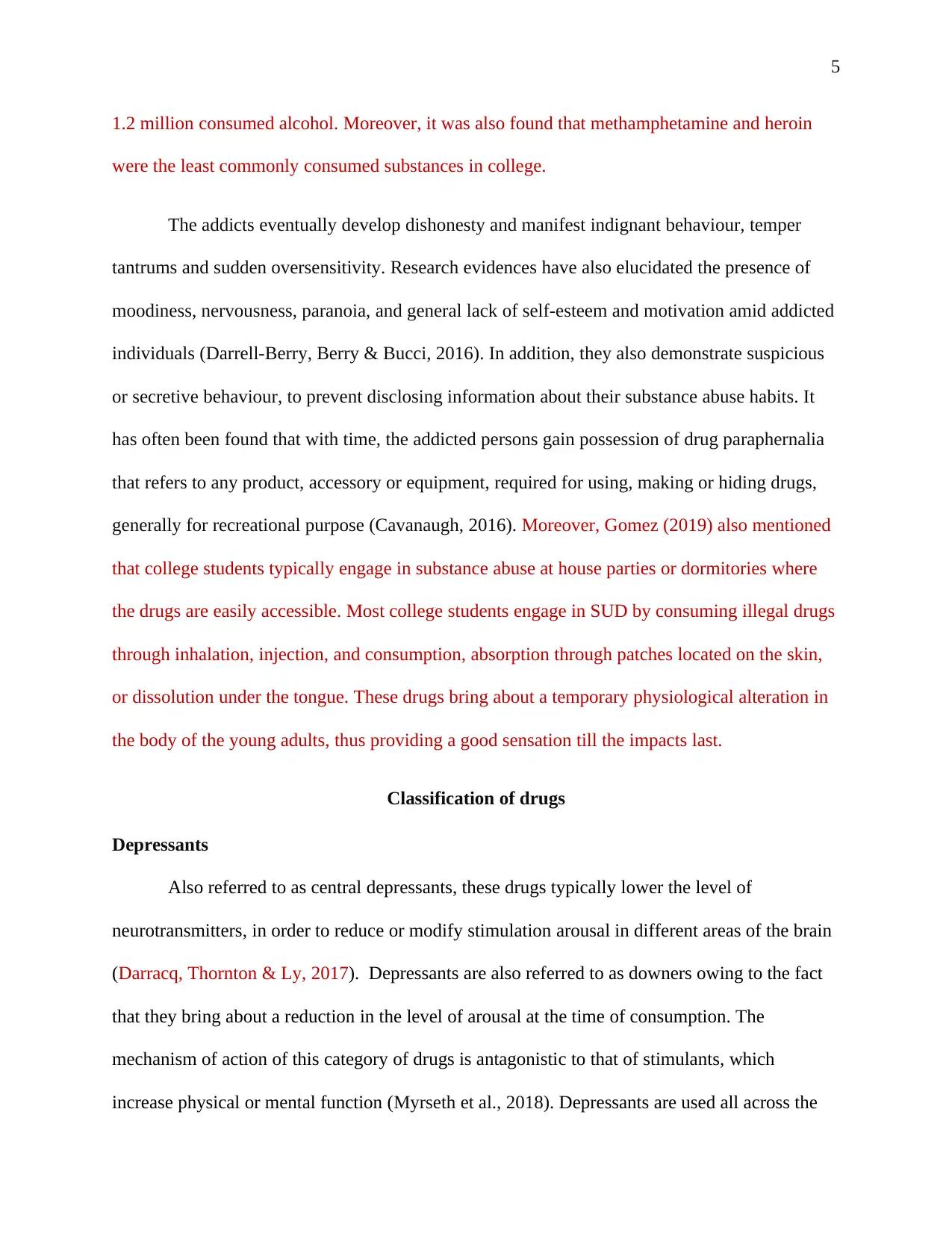
5
1.2 million consumed alcohol. Moreover, it was also found that methamphetamine and heroin
were the least commonly consumed substances in college.
The addicts eventually develop dishonesty and manifest indignant behaviour, temper
tantrums and sudden oversensitivity. Research evidences have also elucidated the presence of
moodiness, nervousness, paranoia, and general lack of self-esteem and motivation amid addicted
individuals (Darrell-Berry, Berry & Bucci, 2016). In addition, they also demonstrate suspicious
or secretive behaviour, to prevent disclosing information about their substance abuse habits. It
has often been found that with time, the addicted persons gain possession of drug paraphernalia
that refers to any product, accessory or equipment, required for using, making or hiding drugs,
generally for recreational purpose (Cavanaugh, 2016). Moreover, Gomez (2019) also mentioned
that college students typically engage in substance abuse at house parties or dormitories where
the drugs are easily accessible. Most college students engage in SUD by consuming illegal drugs
through inhalation, injection, and consumption, absorption through patches located on the skin,
or dissolution under the tongue. These drugs bring about a temporary physiological alteration in
the body of the young adults, thus providing a good sensation till the impacts last.
Classification of drugs
Depressants
Also referred to as central depressants, these drugs typically lower the level of
neurotransmitters, in order to reduce or modify stimulation arousal in different areas of the brain
(Darracq, Thornton & Ly, 2017). Depressants are also referred to as downers owing to the fact
that they bring about a reduction in the level of arousal at the time of consumption. The
mechanism of action of this category of drugs is antagonistic to that of stimulants, which
increase physical or mental function (Myrseth et al., 2018). Depressants are used all across the
1.2 million consumed alcohol. Moreover, it was also found that methamphetamine and heroin
were the least commonly consumed substances in college.
The addicts eventually develop dishonesty and manifest indignant behaviour, temper
tantrums and sudden oversensitivity. Research evidences have also elucidated the presence of
moodiness, nervousness, paranoia, and general lack of self-esteem and motivation amid addicted
individuals (Darrell-Berry, Berry & Bucci, 2016). In addition, they also demonstrate suspicious
or secretive behaviour, to prevent disclosing information about their substance abuse habits. It
has often been found that with time, the addicted persons gain possession of drug paraphernalia
that refers to any product, accessory or equipment, required for using, making or hiding drugs,
generally for recreational purpose (Cavanaugh, 2016). Moreover, Gomez (2019) also mentioned
that college students typically engage in substance abuse at house parties or dormitories where
the drugs are easily accessible. Most college students engage in SUD by consuming illegal drugs
through inhalation, injection, and consumption, absorption through patches located on the skin,
or dissolution under the tongue. These drugs bring about a temporary physiological alteration in
the body of the young adults, thus providing a good sensation till the impacts last.
Classification of drugs
Depressants
Also referred to as central depressants, these drugs typically lower the level of
neurotransmitters, in order to reduce or modify stimulation arousal in different areas of the brain
(Darracq, Thornton & Ly, 2017). Depressants are also referred to as downers owing to the fact
that they bring about a reduction in the level of arousal at the time of consumption. The
mechanism of action of this category of drugs is antagonistic to that of stimulants, which
increase physical or mental function (Myrseth et al., 2018). Depressants are used all across the
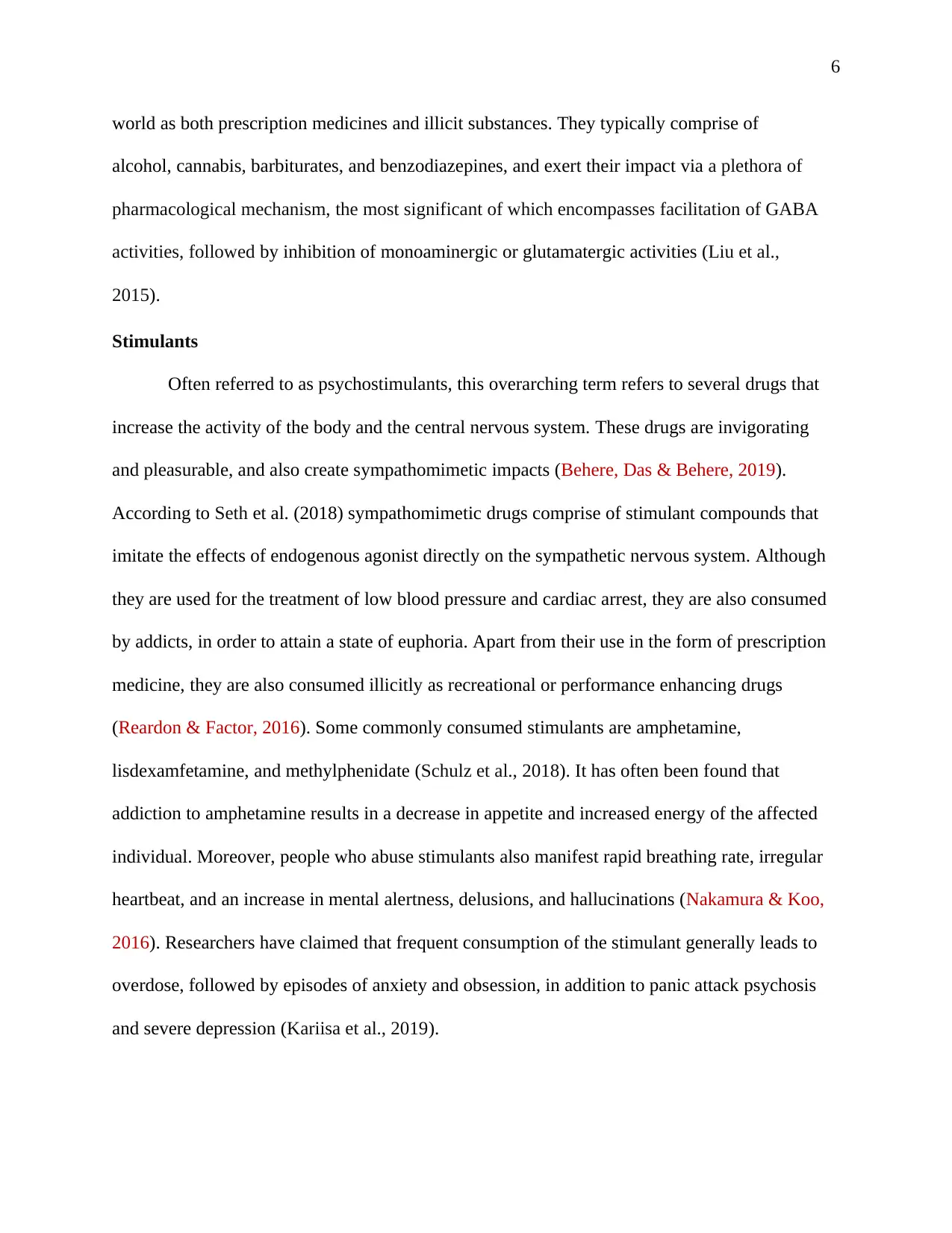
6
world as both prescription medicines and illicit substances. They typically comprise of
alcohol, cannabis, barbiturates, and benzodiazepines, and exert their impact via a plethora of
pharmacological mechanism, the most significant of which encompasses facilitation of GABA
activities, followed by inhibition of monoaminergic or glutamatergic activities (Liu et al.,
2015).
Stimulants
Often referred to as psychostimulants, this overarching term refers to several drugs that
increase the activity of the body and the central nervous system. These drugs are invigorating
and pleasurable, and also create sympathomimetic impacts (Behere, Das & Behere, 2019).
According to Seth et al. (2018) sympathomimetic drugs comprise of stimulant compounds that
imitate the effects of endogenous agonist directly on the sympathetic nervous system. Although
they are used for the treatment of low blood pressure and cardiac arrest, they are also consumed
by addicts, in order to attain a state of euphoria. Apart from their use in the form of prescription
medicine, they are also consumed illicitly as recreational or performance enhancing drugs
(Reardon & Factor, 2016). Some commonly consumed stimulants are amphetamine,
lisdexamfetamine, and methylphenidate (Schulz et al., 2018). It has often been found that
addiction to amphetamine results in a decrease in appetite and increased energy of the affected
individual. Moreover, people who abuse stimulants also manifest rapid breathing rate, irregular
heartbeat, and an increase in mental alertness, delusions, and hallucinations (Nakamura & Koo,
2016). Researchers have claimed that frequent consumption of the stimulant generally leads to
overdose, followed by episodes of anxiety and obsession, in addition to panic attack psychosis
and severe depression (Kariisa et al., 2019).
world as both prescription medicines and illicit substances. They typically comprise of
alcohol, cannabis, barbiturates, and benzodiazepines, and exert their impact via a plethora of
pharmacological mechanism, the most significant of which encompasses facilitation of GABA
activities, followed by inhibition of monoaminergic or glutamatergic activities (Liu et al.,
2015).
Stimulants
Often referred to as psychostimulants, this overarching term refers to several drugs that
increase the activity of the body and the central nervous system. These drugs are invigorating
and pleasurable, and also create sympathomimetic impacts (Behere, Das & Behere, 2019).
According to Seth et al. (2018) sympathomimetic drugs comprise of stimulant compounds that
imitate the effects of endogenous agonist directly on the sympathetic nervous system. Although
they are used for the treatment of low blood pressure and cardiac arrest, they are also consumed
by addicts, in order to attain a state of euphoria. Apart from their use in the form of prescription
medicine, they are also consumed illicitly as recreational or performance enhancing drugs
(Reardon & Factor, 2016). Some commonly consumed stimulants are amphetamine,
lisdexamfetamine, and methylphenidate (Schulz et al., 2018). It has often been found that
addiction to amphetamine results in a decrease in appetite and increased energy of the affected
individual. Moreover, people who abuse stimulants also manifest rapid breathing rate, irregular
heartbeat, and an increase in mental alertness, delusions, and hallucinations (Nakamura & Koo,
2016). Researchers have claimed that frequent consumption of the stimulant generally leads to
overdose, followed by episodes of anxiety and obsession, in addition to panic attack psychosis
and severe depression (Kariisa et al., 2019).
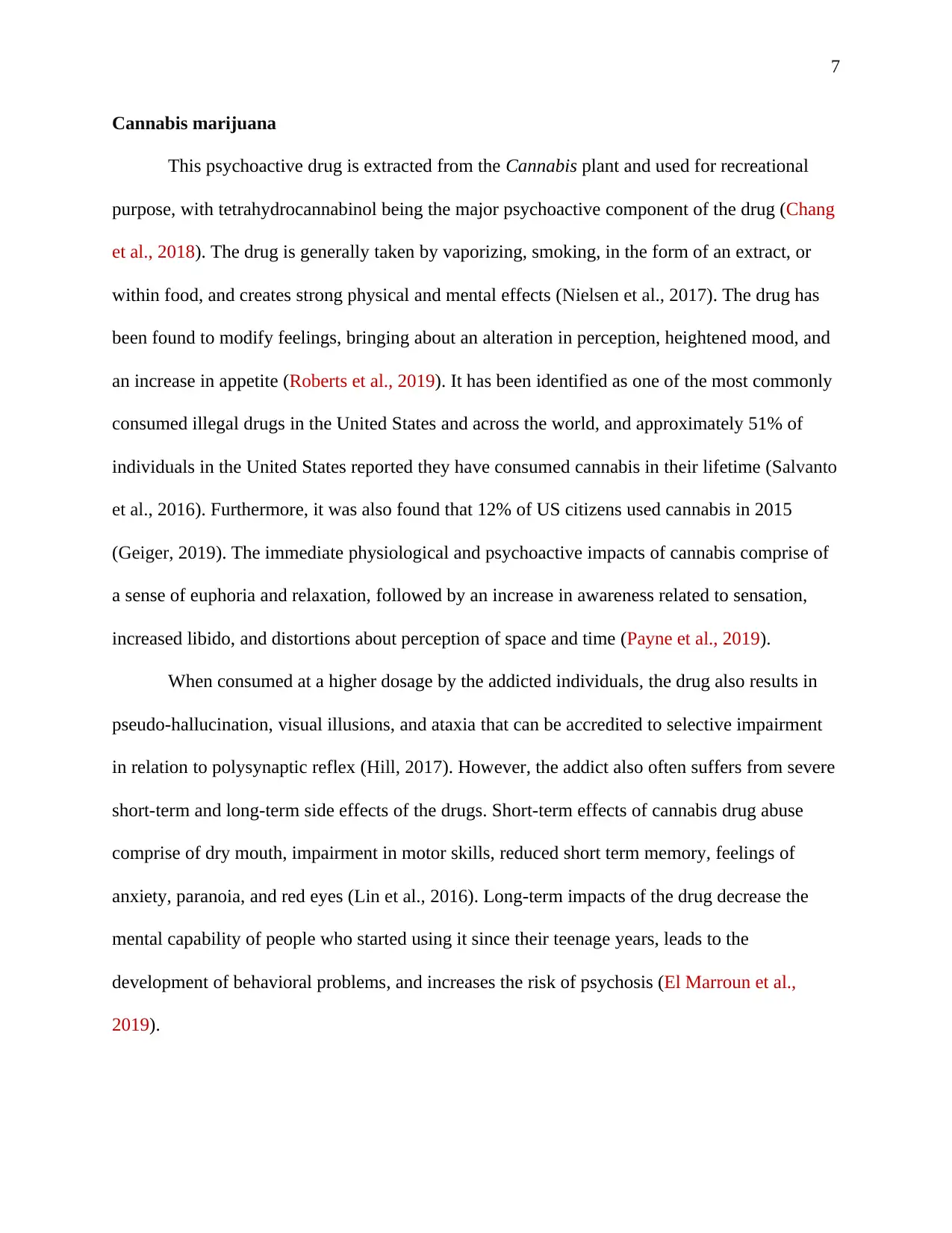
7
Cannabis marijuana
This psychoactive drug is extracted from the Cannabis plant and used for recreational
purpose, with tetrahydrocannabinol being the major psychoactive component of the drug (Chang
et al., 2018). The drug is generally taken by vaporizing, smoking, in the form of an extract, or
within food, and creates strong physical and mental effects (Nielsen et al., 2017). The drug has
been found to modify feelings, bringing about an alteration in perception, heightened mood, and
an increase in appetite (Roberts et al., 2019). It has been identified as one of the most commonly
consumed illegal drugs in the United States and across the world, and approximately 51% of
individuals in the United States reported they have consumed cannabis in their lifetime (Salvanto
et al., 2016). Furthermore, it was also found that 12% of US citizens used cannabis in 2015
(Geiger, 2019). The immediate physiological and psychoactive impacts of cannabis comprise of
a sense of euphoria and relaxation, followed by an increase in awareness related to sensation,
increased libido, and distortions about perception of space and time (Payne et al., 2019).
When consumed at a higher dosage by the addicted individuals, the drug also results in
pseudo-hallucination, visual illusions, and ataxia that can be accredited to selective impairment
in relation to polysynaptic reflex (Hill, 2017). However, the addict also often suffers from severe
short-term and long-term side effects of the drugs. Short-term effects of cannabis drug abuse
comprise of dry mouth, impairment in motor skills, reduced short term memory, feelings of
anxiety, paranoia, and red eyes (Lin et al., 2016). Long-term impacts of the drug decrease the
mental capability of people who started using it since their teenage years, leads to the
development of behavioral problems, and increases the risk of psychosis (El Marroun et al.,
2019).
Cannabis marijuana
This psychoactive drug is extracted from the Cannabis plant and used for recreational
purpose, with tetrahydrocannabinol being the major psychoactive component of the drug (Chang
et al., 2018). The drug is generally taken by vaporizing, smoking, in the form of an extract, or
within food, and creates strong physical and mental effects (Nielsen et al., 2017). The drug has
been found to modify feelings, bringing about an alteration in perception, heightened mood, and
an increase in appetite (Roberts et al., 2019). It has been identified as one of the most commonly
consumed illegal drugs in the United States and across the world, and approximately 51% of
individuals in the United States reported they have consumed cannabis in their lifetime (Salvanto
et al., 2016). Furthermore, it was also found that 12% of US citizens used cannabis in 2015
(Geiger, 2019). The immediate physiological and psychoactive impacts of cannabis comprise of
a sense of euphoria and relaxation, followed by an increase in awareness related to sensation,
increased libido, and distortions about perception of space and time (Payne et al., 2019).
When consumed at a higher dosage by the addicted individuals, the drug also results in
pseudo-hallucination, visual illusions, and ataxia that can be accredited to selective impairment
in relation to polysynaptic reflex (Hill, 2017). However, the addict also often suffers from severe
short-term and long-term side effects of the drugs. Short-term effects of cannabis drug abuse
comprise of dry mouth, impairment in motor skills, reduced short term memory, feelings of
anxiety, paranoia, and red eyes (Lin et al., 2016). Long-term impacts of the drug decrease the
mental capability of people who started using it since their teenage years, leads to the
development of behavioral problems, and increases the risk of psychosis (El Marroun et al.,
2019).
Paraphrase This Document
Need a fresh take? Get an instant paraphrase of this document with our AI Paraphraser
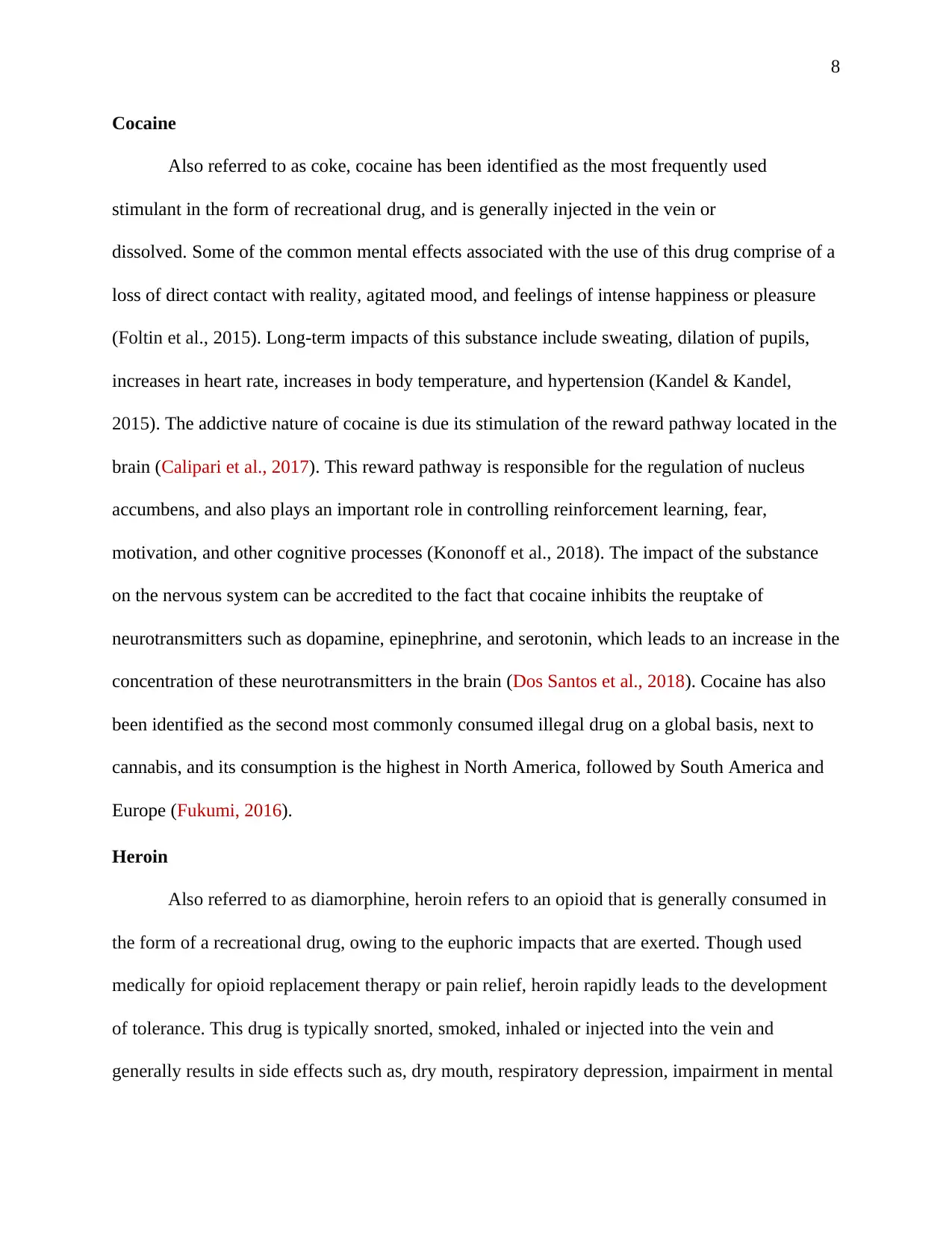
8
Cocaine
Also referred to as coke, cocaine has been identified as the most frequently used
stimulant in the form of recreational drug, and is generally injected in the vein or
dissolved. Some of the common mental effects associated with the use of this drug comprise of a
loss of direct contact with reality, agitated mood, and feelings of intense happiness or pleasure
(Foltin et al., 2015). Long-term impacts of this substance include sweating, dilation of pupils,
increases in heart rate, increases in body temperature, and hypertension (Kandel & Kandel,
2015). The addictive nature of cocaine is due its stimulation of the reward pathway located in the
brain (Calipari et al., 2017). This reward pathway is responsible for the regulation of nucleus
accumbens, and also plays an important role in controlling reinforcement learning, fear,
motivation, and other cognitive processes (Kononoff et al., 2018). The impact of the substance
on the nervous system can be accredited to the fact that cocaine inhibits the reuptake of
neurotransmitters such as dopamine, epinephrine, and serotonin, which leads to an increase in the
concentration of these neurotransmitters in the brain (Dos Santos et al., 2018). Cocaine has also
been identified as the second most commonly consumed illegal drug on a global basis, next to
cannabis, and its consumption is the highest in North America, followed by South America and
Europe (Fukumi, 2016).
Heroin
Also referred to as diamorphine, heroin refers to an opioid that is generally consumed in
the form of a recreational drug, owing to the euphoric impacts that are exerted. Though used
medically for opioid replacement therapy or pain relief, heroin rapidly leads to the development
of tolerance. This drug is typically snorted, smoked, inhaled or injected into the vein and
generally results in side effects such as, dry mouth, respiratory depression, impairment in mental
Cocaine
Also referred to as coke, cocaine has been identified as the most frequently used
stimulant in the form of recreational drug, and is generally injected in the vein or
dissolved. Some of the common mental effects associated with the use of this drug comprise of a
loss of direct contact with reality, agitated mood, and feelings of intense happiness or pleasure
(Foltin et al., 2015). Long-term impacts of this substance include sweating, dilation of pupils,
increases in heart rate, increases in body temperature, and hypertension (Kandel & Kandel,
2015). The addictive nature of cocaine is due its stimulation of the reward pathway located in the
brain (Calipari et al., 2017). This reward pathway is responsible for the regulation of nucleus
accumbens, and also plays an important role in controlling reinforcement learning, fear,
motivation, and other cognitive processes (Kononoff et al., 2018). The impact of the substance
on the nervous system can be accredited to the fact that cocaine inhibits the reuptake of
neurotransmitters such as dopamine, epinephrine, and serotonin, which leads to an increase in the
concentration of these neurotransmitters in the brain (Dos Santos et al., 2018). Cocaine has also
been identified as the second most commonly consumed illegal drug on a global basis, next to
cannabis, and its consumption is the highest in North America, followed by South America and
Europe (Fukumi, 2016).
Heroin
Also referred to as diamorphine, heroin refers to an opioid that is generally consumed in
the form of a recreational drug, owing to the euphoric impacts that are exerted. Though used
medically for opioid replacement therapy or pain relief, heroin rapidly leads to the development
of tolerance. This drug is typically snorted, smoked, inhaled or injected into the vein and
generally results in side effects such as, dry mouth, respiratory depression, impairment in mental
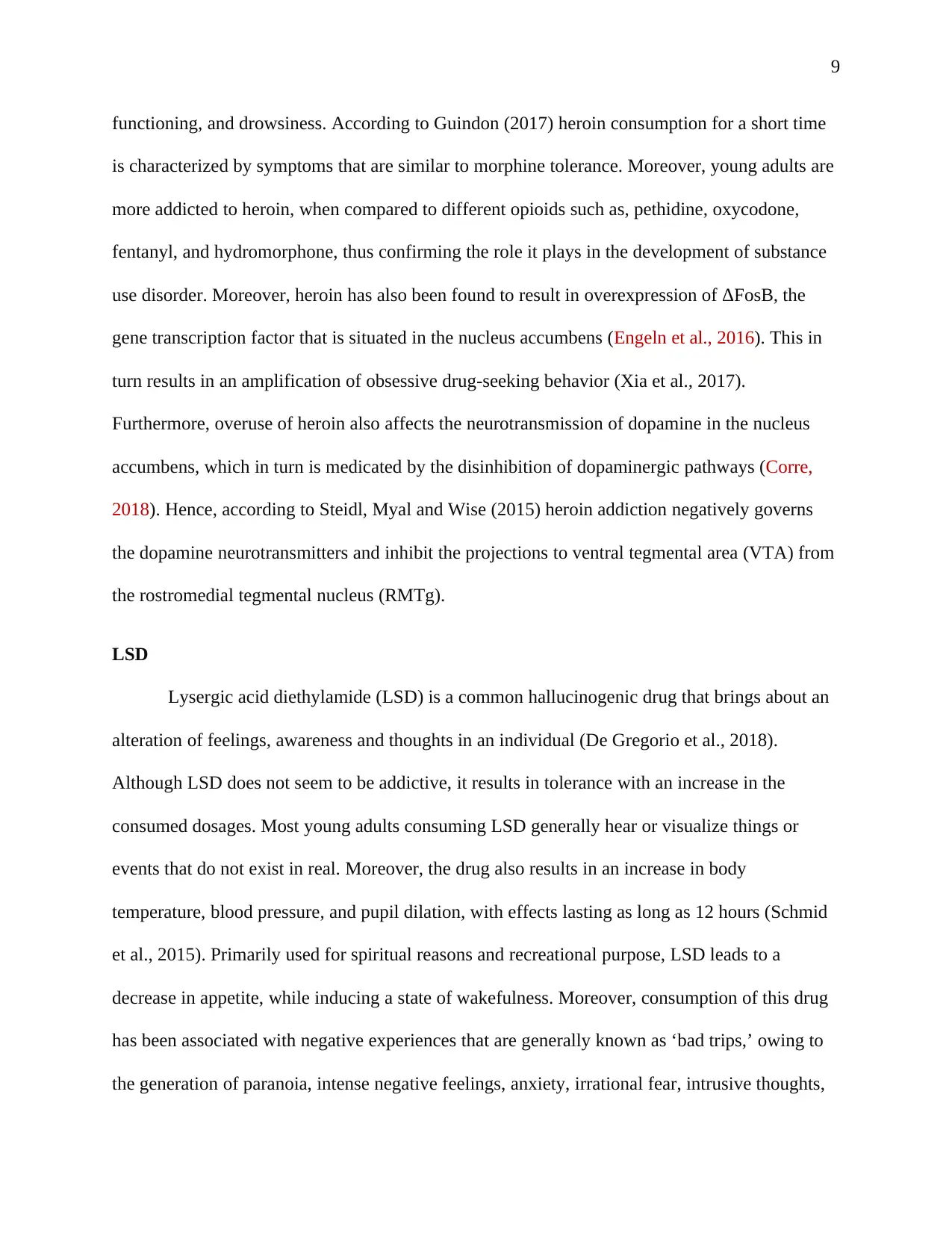
9
functioning, and drowsiness. According to Guindon (2017) heroin consumption for a short time
is characterized by symptoms that are similar to morphine tolerance. Moreover, young adults are
more addicted to heroin, when compared to different opioids such as, pethidine, oxycodone,
fentanyl, and hydromorphone, thus confirming the role it plays in the development of substance
use disorder. Moreover, heroin has also been found to result in overexpression of ΔFosB, the
gene transcription factor that is situated in the nucleus accumbens (Engeln et al., 2016). This in
turn results in an amplification of obsessive drug-seeking behavior (Xia et al., 2017).
Furthermore, overuse of heroin also affects the neurotransmission of dopamine in the nucleus
accumbens, which in turn is medicated by the disinhibition of dopaminergic pathways (Corre,
2018). Hence, according to Steidl, Myal and Wise (2015) heroin addiction negatively governs
the dopamine neurotransmitters and inhibit the projections to ventral tegmental area (VTA) from
the rostromedial tegmental nucleus (RMTg).
LSD
Lysergic acid diethylamide (LSD) is a common hallucinogenic drug that brings about an
alteration of feelings, awareness and thoughts in an individual (De Gregorio et al., 2018).
Although LSD does not seem to be addictive, it results in tolerance with an increase in the
consumed dosages. Most young adults consuming LSD generally hear or visualize things or
events that do not exist in real. Moreover, the drug also results in an increase in body
temperature, blood pressure, and pupil dilation, with effects lasting as long as 12 hours (Schmid
et al., 2015). Primarily used for spiritual reasons and recreational purpose, LSD leads to a
decrease in appetite, while inducing a state of wakefulness. Moreover, consumption of this drug
has been associated with negative experiences that are generally known as ‘bad trips,’ owing to
the generation of paranoia, intense negative feelings, anxiety, irrational fear, intrusive thoughts,
functioning, and drowsiness. According to Guindon (2017) heroin consumption for a short time
is characterized by symptoms that are similar to morphine tolerance. Moreover, young adults are
more addicted to heroin, when compared to different opioids such as, pethidine, oxycodone,
fentanyl, and hydromorphone, thus confirming the role it plays in the development of substance
use disorder. Moreover, heroin has also been found to result in overexpression of ΔFosB, the
gene transcription factor that is situated in the nucleus accumbens (Engeln et al., 2016). This in
turn results in an amplification of obsessive drug-seeking behavior (Xia et al., 2017).
Furthermore, overuse of heroin also affects the neurotransmission of dopamine in the nucleus
accumbens, which in turn is medicated by the disinhibition of dopaminergic pathways (Corre,
2018). Hence, according to Steidl, Myal and Wise (2015) heroin addiction negatively governs
the dopamine neurotransmitters and inhibit the projections to ventral tegmental area (VTA) from
the rostromedial tegmental nucleus (RMTg).
LSD
Lysergic acid diethylamide (LSD) is a common hallucinogenic drug that brings about an
alteration of feelings, awareness and thoughts in an individual (De Gregorio et al., 2018).
Although LSD does not seem to be addictive, it results in tolerance with an increase in the
consumed dosages. Most young adults consuming LSD generally hear or visualize things or
events that do not exist in real. Moreover, the drug also results in an increase in body
temperature, blood pressure, and pupil dilation, with effects lasting as long as 12 hours (Schmid
et al., 2015). Primarily used for spiritual reasons and recreational purpose, LSD leads to a
decrease in appetite, while inducing a state of wakefulness. Moreover, consumption of this drug
has been associated with negative experiences that are generally known as ‘bad trips,’ owing to
the generation of paranoia, intense negative feelings, anxiety, irrational fear, intrusive thoughts,
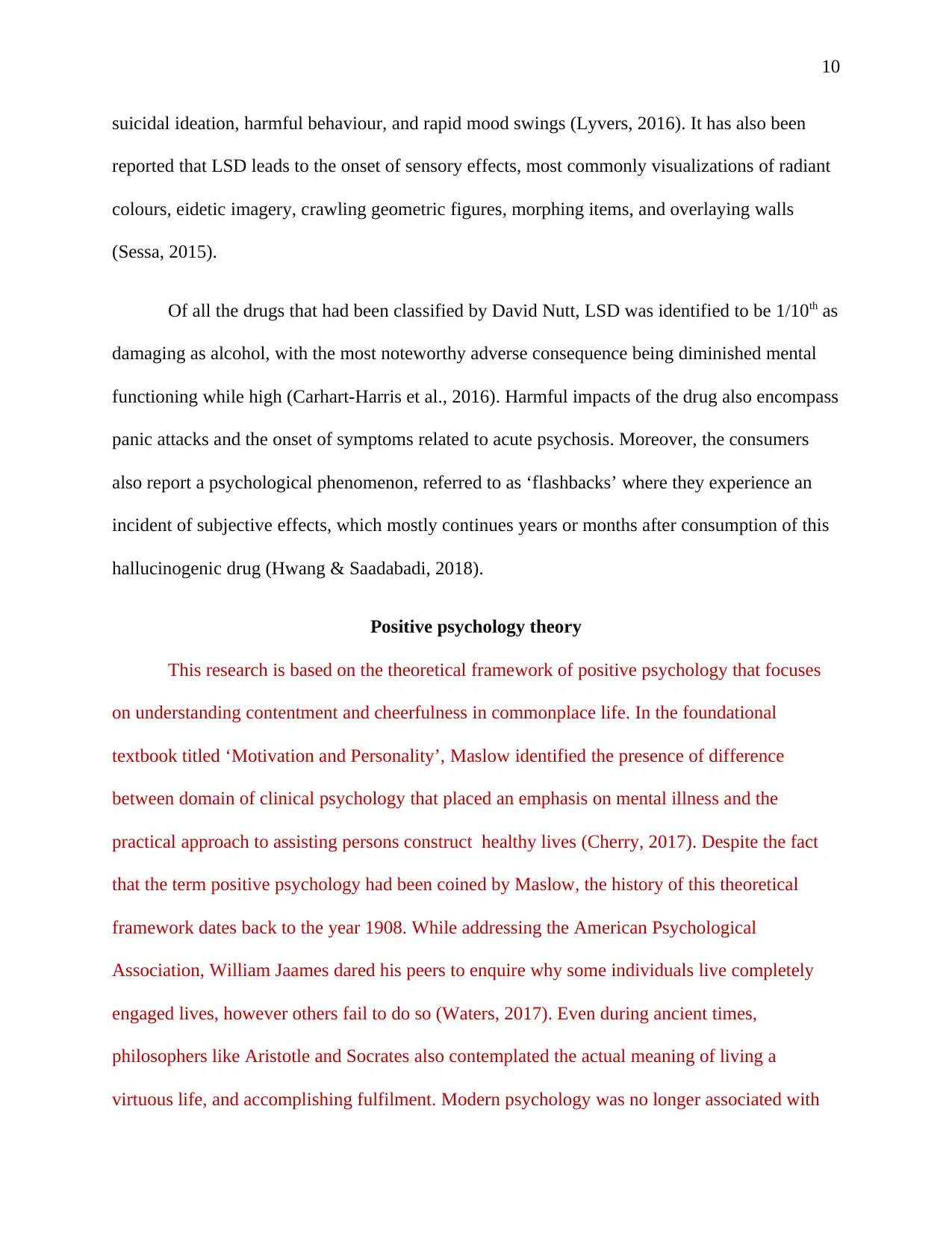
10
suicidal ideation, harmful behaviour, and rapid mood swings (Lyvers, 2016). It has also been
reported that LSD leads to the onset of sensory effects, most commonly visualizations of radiant
colours, eidetic imagery, crawling geometric figures, morphing items, and overlaying walls
(Sessa, 2015).
Of all the drugs that had been classified by David Nutt, LSD was identified to be 1/10th as
damaging as alcohol, with the most noteworthy adverse consequence being diminished mental
functioning while high (Carhart-Harris et al., 2016). Harmful impacts of the drug also encompass
panic attacks and the onset of symptoms related to acute psychosis. Moreover, the consumers
also report a psychological phenomenon, referred to as ‘flashbacks’ where they experience an
incident of subjective effects, which mostly continues years or months after consumption of this
hallucinogenic drug (Hwang & Saadabadi, 2018).
Positive psychology theory
This research is based on the theoretical framework of positive psychology that focuses
on understanding contentment and cheerfulness in commonplace life. In the foundational
textbook titled ‘Motivation and Personality’, Maslow identified the presence of difference
between domain of clinical psychology that placed an emphasis on mental illness and the
practical approach to assisting persons construct healthy lives (Cherry, 2017). Despite the fact
that the term positive psychology had been coined by Maslow, the history of this theoretical
framework dates back to the year 1908. While addressing the American Psychological
Association, William Jaames dared his peers to enquire why some individuals live completely
engaged lives, however others fail to do so (Waters, 2017). Even during ancient times,
philosophers like Aristotle and Socrates also contemplated the actual meaning of living a
virtuous life, and accomplishing fulfilment. Modern psychology was no longer associated with
suicidal ideation, harmful behaviour, and rapid mood swings (Lyvers, 2016). It has also been
reported that LSD leads to the onset of sensory effects, most commonly visualizations of radiant
colours, eidetic imagery, crawling geometric figures, morphing items, and overlaying walls
(Sessa, 2015).
Of all the drugs that had been classified by David Nutt, LSD was identified to be 1/10th as
damaging as alcohol, with the most noteworthy adverse consequence being diminished mental
functioning while high (Carhart-Harris et al., 2016). Harmful impacts of the drug also encompass
panic attacks and the onset of symptoms related to acute psychosis. Moreover, the consumers
also report a psychological phenomenon, referred to as ‘flashbacks’ where they experience an
incident of subjective effects, which mostly continues years or months after consumption of this
hallucinogenic drug (Hwang & Saadabadi, 2018).
Positive psychology theory
This research is based on the theoretical framework of positive psychology that focuses
on understanding contentment and cheerfulness in commonplace life. In the foundational
textbook titled ‘Motivation and Personality’, Maslow identified the presence of difference
between domain of clinical psychology that placed an emphasis on mental illness and the
practical approach to assisting persons construct healthy lives (Cherry, 2017). Despite the fact
that the term positive psychology had been coined by Maslow, the history of this theoretical
framework dates back to the year 1908. While addressing the American Psychological
Association, William Jaames dared his peers to enquire why some individuals live completely
engaged lives, however others fail to do so (Waters, 2017). Even during ancient times,
philosophers like Aristotle and Socrates also contemplated the actual meaning of living a
virtuous life, and accomplishing fulfilment. Modern psychology was no longer associated with
Secure Best Marks with AI Grader
Need help grading? Try our AI Grader for instant feedback on your assignments.
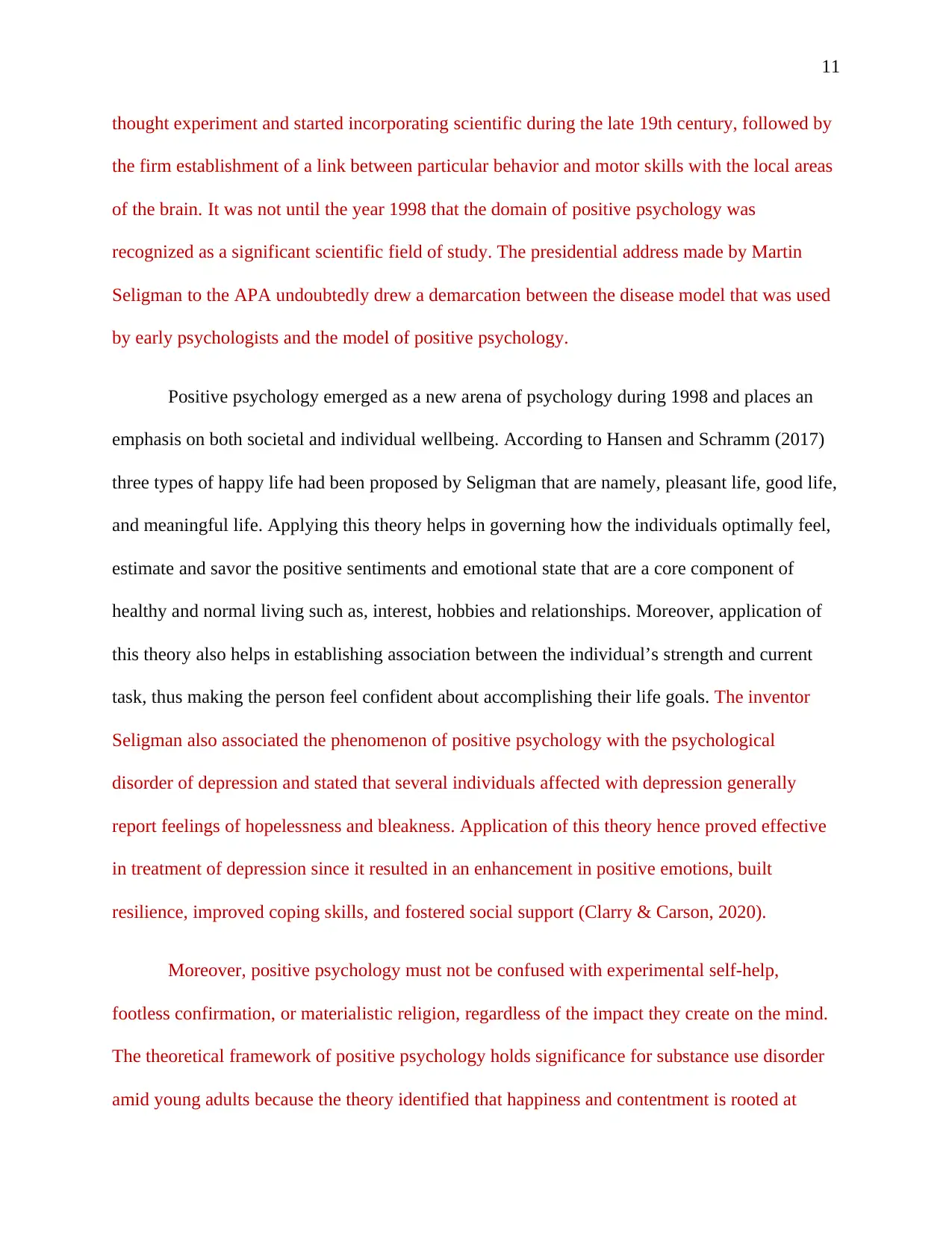
11
thought experiment and started incorporating scientific during the late 19th century, followed by
the firm establishment of a link between particular behavior and motor skills with the local areas
of the brain. It was not until the year 1998 that the domain of positive psychology was
recognized as a significant scientific field of study. The presidential address made by Martin
Seligman to the APA undoubtedly drew a demarcation between the disease model that was used
by early psychologists and the model of positive psychology.
Positive psychology emerged as a new arena of psychology during 1998 and places an
emphasis on both societal and individual wellbeing. According to Hansen and Schramm (2017)
three types of happy life had been proposed by Seligman that are namely, pleasant life, good life,
and meaningful life. Applying this theory helps in governing how the individuals optimally feel,
estimate and savor the positive sentiments and emotional state that are a core component of
healthy and normal living such as, interest, hobbies and relationships. Moreover, application of
this theory also helps in establishing association between the individual’s strength and current
task, thus making the person feel confident about accomplishing their life goals. The inventor
Seligman also associated the phenomenon of positive psychology with the psychological
disorder of depression and stated that several individuals affected with depression generally
report feelings of hopelessness and bleakness. Application of this theory hence proved effective
in treatment of depression since it resulted in an enhancement in positive emotions, built
resilience, improved coping skills, and fostered social support (Clarry & Carson, 2020).
Moreover, positive psychology must not be confused with experimental self-help,
footless confirmation, or materialistic religion, regardless of the impact they create on the mind.
The theoretical framework of positive psychology holds significance for substance use disorder
amid young adults because the theory identified that happiness and contentment is rooted at
thought experiment and started incorporating scientific during the late 19th century, followed by
the firm establishment of a link between particular behavior and motor skills with the local areas
of the brain. It was not until the year 1998 that the domain of positive psychology was
recognized as a significant scientific field of study. The presidential address made by Martin
Seligman to the APA undoubtedly drew a demarcation between the disease model that was used
by early psychologists and the model of positive psychology.
Positive psychology emerged as a new arena of psychology during 1998 and places an
emphasis on both societal and individual wellbeing. According to Hansen and Schramm (2017)
three types of happy life had been proposed by Seligman that are namely, pleasant life, good life,
and meaningful life. Applying this theory helps in governing how the individuals optimally feel,
estimate and savor the positive sentiments and emotional state that are a core component of
healthy and normal living such as, interest, hobbies and relationships. Moreover, application of
this theory also helps in establishing association between the individual’s strength and current
task, thus making the person feel confident about accomplishing their life goals. The inventor
Seligman also associated the phenomenon of positive psychology with the psychological
disorder of depression and stated that several individuals affected with depression generally
report feelings of hopelessness and bleakness. Application of this theory hence proved effective
in treatment of depression since it resulted in an enhancement in positive emotions, built
resilience, improved coping skills, and fostered social support (Clarry & Carson, 2020).
Moreover, positive psychology must not be confused with experimental self-help,
footless confirmation, or materialistic religion, regardless of the impact they create on the mind.
The theoretical framework of positive psychology holds significance for substance use disorder
amid young adults because the theory identified that happiness and contentment is rooted at
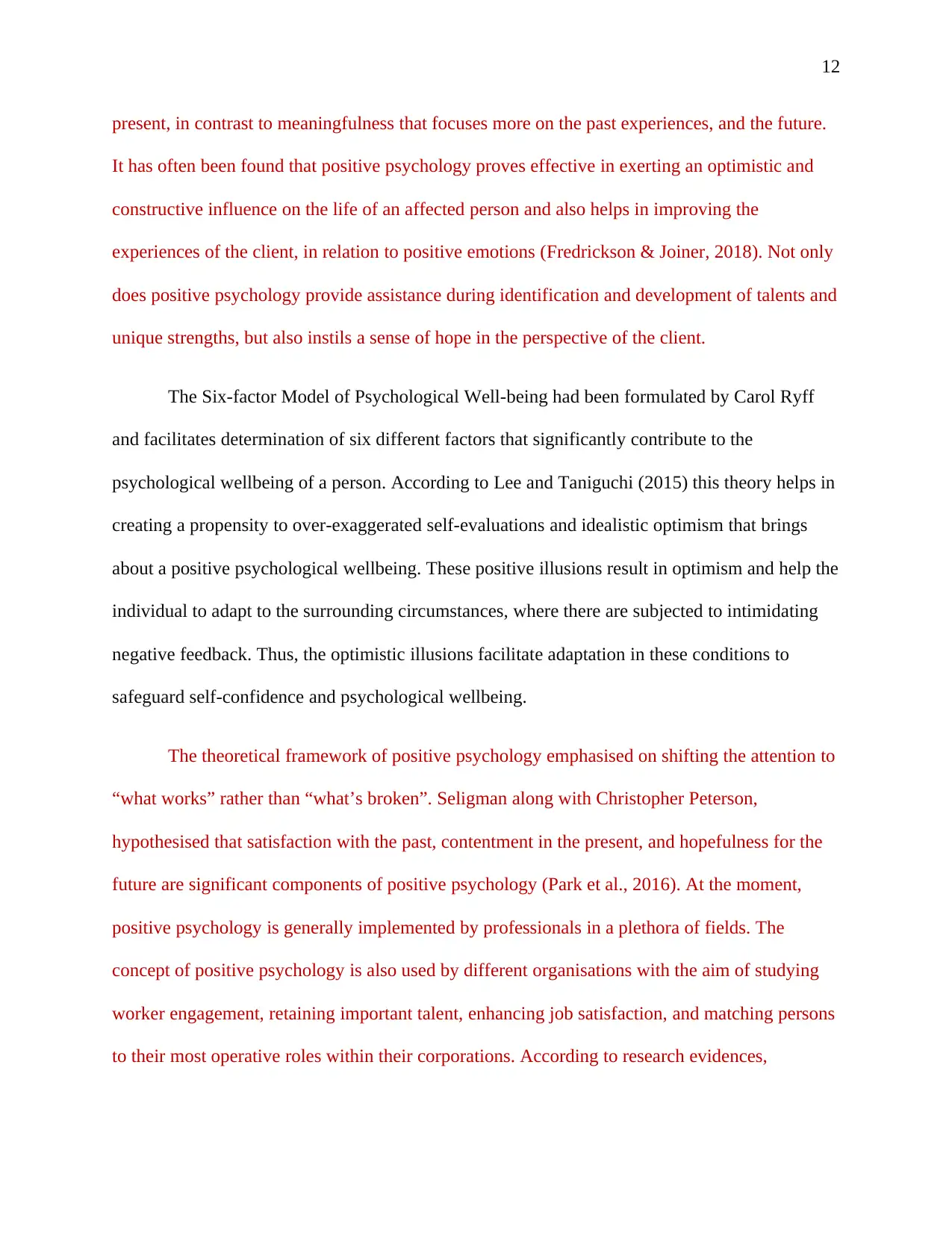
12
present, in contrast to meaningfulness that focuses more on the past experiences, and the future.
It has often been found that positive psychology proves effective in exerting an optimistic and
constructive influence on the life of an affected person and also helps in improving the
experiences of the client, in relation to positive emotions (Fredrickson & Joiner, 2018). Not only
does positive psychology provide assistance during identification and development of talents and
unique strengths, but also instils a sense of hope in the perspective of the client.
The Six-factor Model of Psychological Well-being had been formulated by Carol Ryff
and facilitates determination of six different factors that significantly contribute to the
psychological wellbeing of a person. According to Lee and Taniguchi (2015) this theory helps in
creating a propensity to over-exaggerated self-evaluations and idealistic optimism that brings
about a positive psychological wellbeing. These positive illusions result in optimism and help the
individual to adapt to the surrounding circumstances, where there are subjected to intimidating
negative feedback. Thus, the optimistic illusions facilitate adaptation in these conditions to
safeguard self-confidence and psychological wellbeing.
The theoretical framework of positive psychology emphasised on shifting the attention to
“what works” rather than “what’s broken”. Seligman along with Christopher Peterson,
hypothesised that satisfaction with the past, contentment in the present, and hopefulness for the
future are significant components of positive psychology (Park et al., 2016). At the moment,
positive psychology is generally implemented by professionals in a plethora of fields. The
concept of positive psychology is also used by different organisations with the aim of studying
worker engagement, retaining important talent, enhancing job satisfaction, and matching persons
to their most operative roles within their corporations. According to research evidences,
present, in contrast to meaningfulness that focuses more on the past experiences, and the future.
It has often been found that positive psychology proves effective in exerting an optimistic and
constructive influence on the life of an affected person and also helps in improving the
experiences of the client, in relation to positive emotions (Fredrickson & Joiner, 2018). Not only
does positive psychology provide assistance during identification and development of talents and
unique strengths, but also instils a sense of hope in the perspective of the client.
The Six-factor Model of Psychological Well-being had been formulated by Carol Ryff
and facilitates determination of six different factors that significantly contribute to the
psychological wellbeing of a person. According to Lee and Taniguchi (2015) this theory helps in
creating a propensity to over-exaggerated self-evaluations and idealistic optimism that brings
about a positive psychological wellbeing. These positive illusions result in optimism and help the
individual to adapt to the surrounding circumstances, where there are subjected to intimidating
negative feedback. Thus, the optimistic illusions facilitate adaptation in these conditions to
safeguard self-confidence and psychological wellbeing.
The theoretical framework of positive psychology emphasised on shifting the attention to
“what works” rather than “what’s broken”. Seligman along with Christopher Peterson,
hypothesised that satisfaction with the past, contentment in the present, and hopefulness for the
future are significant components of positive psychology (Park et al., 2016). At the moment,
positive psychology is generally implemented by professionals in a plethora of fields. The
concept of positive psychology is also used by different organisations with the aim of studying
worker engagement, retaining important talent, enhancing job satisfaction, and matching persons
to their most operative roles within their corporations. According to research evidences,
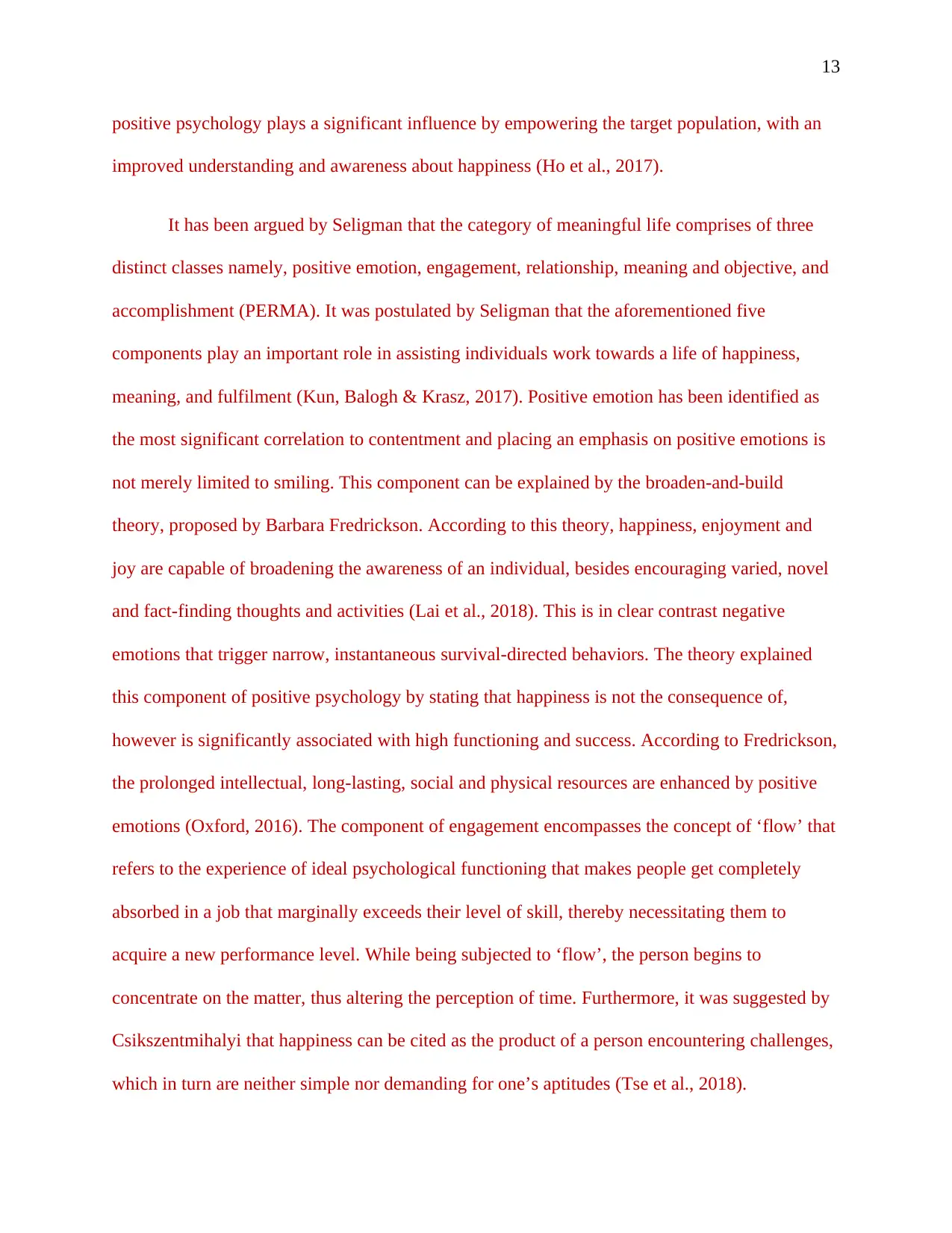
13
positive psychology plays a significant influence by empowering the target population, with an
improved understanding and awareness about happiness (Ho et al., 2017).
It has been argued by Seligman that the category of meaningful life comprises of three
distinct classes namely, positive emotion, engagement, relationship, meaning and objective, and
accomplishment (PERMA). It was postulated by Seligman that the aforementioned five
components play an important role in assisting individuals work towards a life of happiness,
meaning, and fulfilment (Kun, Balogh & Krasz, 2017). Positive emotion has been identified as
the most significant correlation to contentment and placing an emphasis on positive emotions is
not merely limited to smiling. This component can be explained by the broaden-and-build
theory, proposed by Barbara Fredrickson. According to this theory, happiness, enjoyment and
joy are capable of broadening the awareness of an individual, besides encouraging varied, novel
and fact-finding thoughts and activities (Lai et al., 2018). This is in clear contrast negative
emotions that trigger narrow, instantaneous survival-directed behaviors. The theory explained
this component of positive psychology by stating that happiness is not the consequence of,
however is significantly associated with high functioning and success. According to Fredrickson,
the prolonged intellectual, long-lasting, social and physical resources are enhanced by positive
emotions (Oxford, 2016). The component of engagement encompasses the concept of ‘flow’ that
refers to the experience of ideal psychological functioning that makes people get completely
absorbed in a job that marginally exceeds their level of skill, thereby necessitating them to
acquire a new performance level. While being subjected to ‘flow’, the person begins to
concentrate on the matter, thus altering the perception of time. Furthermore, it was suggested by
Csikszentmihalyi that happiness can be cited as the product of a person encountering challenges,
which in turn are neither simple nor demanding for one’s aptitudes (Tse et al., 2018).
positive psychology plays a significant influence by empowering the target population, with an
improved understanding and awareness about happiness (Ho et al., 2017).
It has been argued by Seligman that the category of meaningful life comprises of three
distinct classes namely, positive emotion, engagement, relationship, meaning and objective, and
accomplishment (PERMA). It was postulated by Seligman that the aforementioned five
components play an important role in assisting individuals work towards a life of happiness,
meaning, and fulfilment (Kun, Balogh & Krasz, 2017). Positive emotion has been identified as
the most significant correlation to contentment and placing an emphasis on positive emotions is
not merely limited to smiling. This component can be explained by the broaden-and-build
theory, proposed by Barbara Fredrickson. According to this theory, happiness, enjoyment and
joy are capable of broadening the awareness of an individual, besides encouraging varied, novel
and fact-finding thoughts and activities (Lai et al., 2018). This is in clear contrast negative
emotions that trigger narrow, instantaneous survival-directed behaviors. The theory explained
this component of positive psychology by stating that happiness is not the consequence of,
however is significantly associated with high functioning and success. According to Fredrickson,
the prolonged intellectual, long-lasting, social and physical resources are enhanced by positive
emotions (Oxford, 2016). The component of engagement encompasses the concept of ‘flow’ that
refers to the experience of ideal psychological functioning that makes people get completely
absorbed in a job that marginally exceeds their level of skill, thereby necessitating them to
acquire a new performance level. While being subjected to ‘flow’, the person begins to
concentrate on the matter, thus altering the perception of time. Furthermore, it was suggested by
Csikszentmihalyi that happiness can be cited as the product of a person encountering challenges,
which in turn are neither simple nor demanding for one’s aptitudes (Tse et al., 2018).
Paraphrase This Document
Need a fresh take? Get an instant paraphrase of this document with our AI Paraphraser
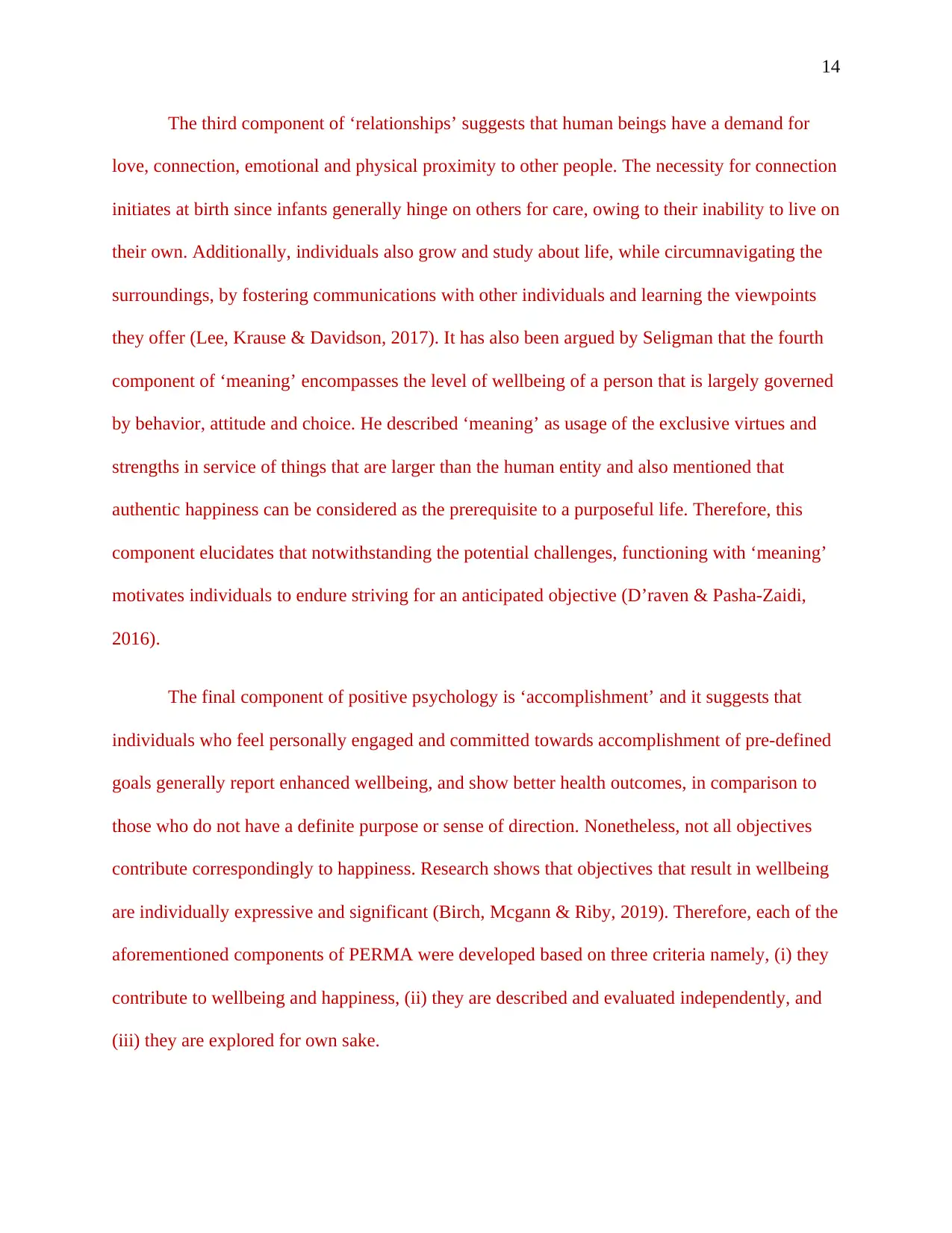
14
The third component of ‘relationships’ suggests that human beings have a demand for
love, connection, emotional and physical proximity to other people. The necessity for connection
initiates at birth since infants generally hinge on others for care, owing to their inability to live on
their own. Additionally, individuals also grow and study about life, while circumnavigating the
surroundings, by fostering communications with other individuals and learning the viewpoints
they offer (Lee, Krause & Davidson, 2017). It has also been argued by Seligman that the fourth
component of ‘meaning’ encompasses the level of wellbeing of a person that is largely governed
by behavior, attitude and choice. He described ‘meaning’ as usage of the exclusive virtues and
strengths in service of things that are larger than the human entity and also mentioned that
authentic happiness can be considered as the prerequisite to a purposeful life. Therefore, this
component elucidates that notwithstanding the potential challenges, functioning with ‘meaning’
motivates individuals to endure striving for an anticipated objective (D’raven & Pasha-Zaidi,
2016).
The final component of positive psychology is ‘accomplishment’ and it suggests that
individuals who feel personally engaged and committed towards accomplishment of pre-defined
goals generally report enhanced wellbeing, and show better health outcomes, in comparison to
those who do not have a definite purpose or sense of direction. Nonetheless, not all objectives
contribute correspondingly to happiness. Research shows that objectives that result in wellbeing
are individually expressive and significant (Birch, Mcgann & Riby, 2019). Therefore, each of the
aforementioned components of PERMA were developed based on three criteria namely, (i) they
contribute to wellbeing and happiness, (ii) they are described and evaluated independently, and
(iii) they are explored for own sake.
The third component of ‘relationships’ suggests that human beings have a demand for
love, connection, emotional and physical proximity to other people. The necessity for connection
initiates at birth since infants generally hinge on others for care, owing to their inability to live on
their own. Additionally, individuals also grow and study about life, while circumnavigating the
surroundings, by fostering communications with other individuals and learning the viewpoints
they offer (Lee, Krause & Davidson, 2017). It has also been argued by Seligman that the fourth
component of ‘meaning’ encompasses the level of wellbeing of a person that is largely governed
by behavior, attitude and choice. He described ‘meaning’ as usage of the exclusive virtues and
strengths in service of things that are larger than the human entity and also mentioned that
authentic happiness can be considered as the prerequisite to a purposeful life. Therefore, this
component elucidates that notwithstanding the potential challenges, functioning with ‘meaning’
motivates individuals to endure striving for an anticipated objective (D’raven & Pasha-Zaidi,
2016).
The final component of positive psychology is ‘accomplishment’ and it suggests that
individuals who feel personally engaged and committed towards accomplishment of pre-defined
goals generally report enhanced wellbeing, and show better health outcomes, in comparison to
those who do not have a definite purpose or sense of direction. Nonetheless, not all objectives
contribute correspondingly to happiness. Research shows that objectives that result in wellbeing
are individually expressive and significant (Birch, Mcgann & Riby, 2019). Therefore, each of the
aforementioned components of PERMA were developed based on three criteria namely, (i) they
contribute to wellbeing and happiness, (ii) they are described and evaluated independently, and
(iii) they are explored for own sake.
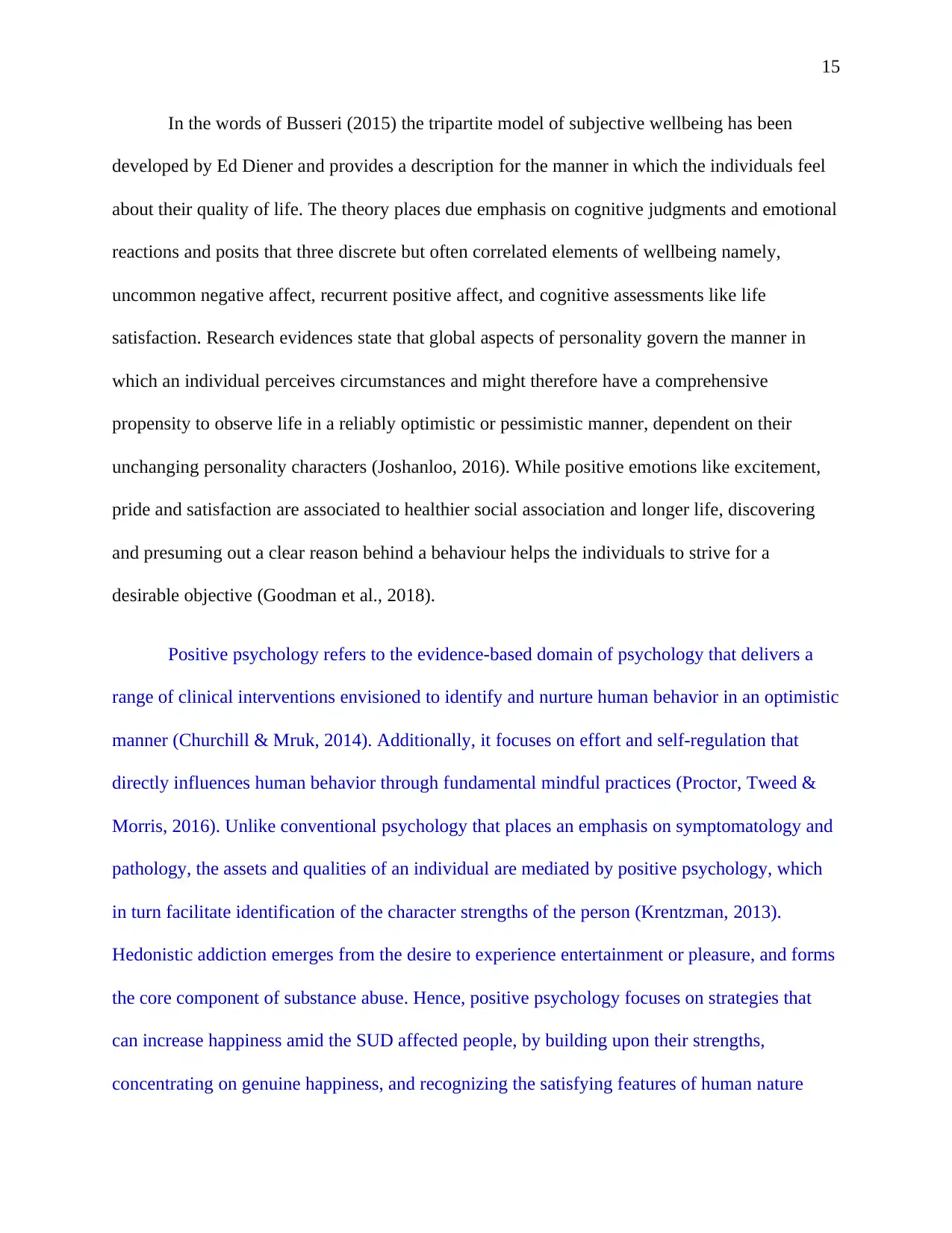
15
In the words of Busseri (2015) the tripartite model of subjective wellbeing has been
developed by Ed Diener and provides a description for the manner in which the individuals feel
about their quality of life. The theory places due emphasis on cognitive judgments and emotional
reactions and posits that three discrete but often correlated elements of wellbeing namely,
uncommon negative affect, recurrent positive affect, and cognitive assessments like life
satisfaction. Research evidences state that global aspects of personality govern the manner in
which an individual perceives circumstances and might therefore have a comprehensive
propensity to observe life in a reliably optimistic or pessimistic manner, dependent on their
unchanging personality characters (Joshanloo, 2016). While positive emotions like excitement,
pride and satisfaction are associated to healthier social association and longer life, discovering
and presuming out a clear reason behind a behaviour helps the individuals to strive for a
desirable objective (Goodman et al., 2018).
Positive psychology refers to the evidence-based domain of psychology that delivers a
range of clinical interventions envisioned to identify and nurture human behavior in an optimistic
manner (Churchill & Mruk, 2014). Additionally, it focuses on effort and self-regulation that
directly influences human behavior through fundamental mindful practices (Proctor, Tweed &
Morris, 2016). Unlike conventional psychology that places an emphasis on symptomatology and
pathology, the assets and qualities of an individual are mediated by positive psychology, which
in turn facilitate identification of the character strengths of the person (Krentzman, 2013).
Hedonistic addiction emerges from the desire to experience entertainment or pleasure, and forms
the core component of substance abuse. Hence, positive psychology focuses on strategies that
can increase happiness amid the SUD affected people, by building upon their strengths,
concentrating on genuine happiness, and recognizing the satisfying features of human nature
In the words of Busseri (2015) the tripartite model of subjective wellbeing has been
developed by Ed Diener and provides a description for the manner in which the individuals feel
about their quality of life. The theory places due emphasis on cognitive judgments and emotional
reactions and posits that three discrete but often correlated elements of wellbeing namely,
uncommon negative affect, recurrent positive affect, and cognitive assessments like life
satisfaction. Research evidences state that global aspects of personality govern the manner in
which an individual perceives circumstances and might therefore have a comprehensive
propensity to observe life in a reliably optimistic or pessimistic manner, dependent on their
unchanging personality characters (Joshanloo, 2016). While positive emotions like excitement,
pride and satisfaction are associated to healthier social association and longer life, discovering
and presuming out a clear reason behind a behaviour helps the individuals to strive for a
desirable objective (Goodman et al., 2018).
Positive psychology refers to the evidence-based domain of psychology that delivers a
range of clinical interventions envisioned to identify and nurture human behavior in an optimistic
manner (Churchill & Mruk, 2014). Additionally, it focuses on effort and self-regulation that
directly influences human behavior through fundamental mindful practices (Proctor, Tweed &
Morris, 2016). Unlike conventional psychology that places an emphasis on symptomatology and
pathology, the assets and qualities of an individual are mediated by positive psychology, which
in turn facilitate identification of the character strengths of the person (Krentzman, 2013).
Hedonistic addiction emerges from the desire to experience entertainment or pleasure, and forms
the core component of substance abuse. Hence, positive psychology focuses on strategies that
can increase happiness amid the SUD affected people, by building upon their strengths,
concentrating on genuine happiness, and recognizing the satisfying features of human nature
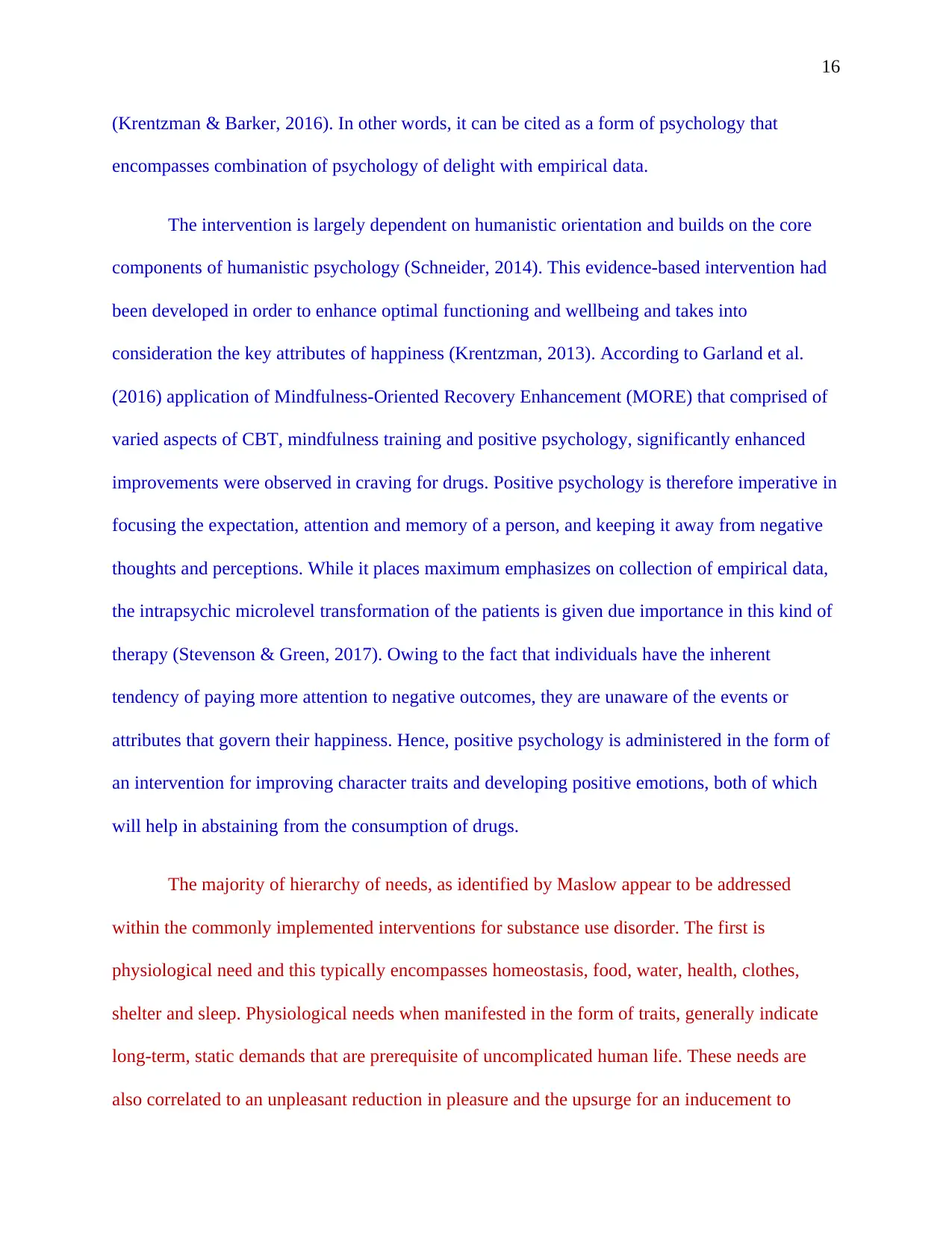
16
(Krentzman & Barker, 2016). In other words, it can be cited as a form of psychology that
encompasses combination of psychology of delight with empirical data.
The intervention is largely dependent on humanistic orientation and builds on the core
components of humanistic psychology (Schneider, 2014). This evidence-based intervention had
been developed in order to enhance optimal functioning and wellbeing and takes into
consideration the key attributes of happiness (Krentzman, 2013). According to Garland et al.
(2016) application of Mindfulness-Oriented Recovery Enhancement (MORE) that comprised of
varied aspects of CBT, mindfulness training and positive psychology, significantly enhanced
improvements were observed in craving for drugs. Positive psychology is therefore imperative in
focusing the expectation, attention and memory of a person, and keeping it away from negative
thoughts and perceptions. While it places maximum emphasizes on collection of empirical data,
the intrapsychic microlevel transformation of the patients is given due importance in this kind of
therapy (Stevenson & Green, 2017). Owing to the fact that individuals have the inherent
tendency of paying more attention to negative outcomes, they are unaware of the events or
attributes that govern their happiness. Hence, positive psychology is administered in the form of
an intervention for improving character traits and developing positive emotions, both of which
will help in abstaining from the consumption of drugs.
The majority of hierarchy of needs, as identified by Maslow appear to be addressed
within the commonly implemented interventions for substance use disorder. The first is
physiological need and this typically encompasses homeostasis, food, water, health, clothes,
shelter and sleep. Physiological needs when manifested in the form of traits, generally indicate
long-term, static demands that are prerequisite of uncomplicated human life. These needs are
also correlated to an unpleasant reduction in pleasure and the upsurge for an inducement to
(Krentzman & Barker, 2016). In other words, it can be cited as a form of psychology that
encompasses combination of psychology of delight with empirical data.
The intervention is largely dependent on humanistic orientation and builds on the core
components of humanistic psychology (Schneider, 2014). This evidence-based intervention had
been developed in order to enhance optimal functioning and wellbeing and takes into
consideration the key attributes of happiness (Krentzman, 2013). According to Garland et al.
(2016) application of Mindfulness-Oriented Recovery Enhancement (MORE) that comprised of
varied aspects of CBT, mindfulness training and positive psychology, significantly enhanced
improvements were observed in craving for drugs. Positive psychology is therefore imperative in
focusing the expectation, attention and memory of a person, and keeping it away from negative
thoughts and perceptions. While it places maximum emphasizes on collection of empirical data,
the intrapsychic microlevel transformation of the patients is given due importance in this kind of
therapy (Stevenson & Green, 2017). Owing to the fact that individuals have the inherent
tendency of paying more attention to negative outcomes, they are unaware of the events or
attributes that govern their happiness. Hence, positive psychology is administered in the form of
an intervention for improving character traits and developing positive emotions, both of which
will help in abstaining from the consumption of drugs.
The majority of hierarchy of needs, as identified by Maslow appear to be addressed
within the commonly implemented interventions for substance use disorder. The first is
physiological need and this typically encompasses homeostasis, food, water, health, clothes,
shelter and sleep. Physiological needs when manifested in the form of traits, generally indicate
long-term, static demands that are prerequisite of uncomplicated human life. These needs are
also correlated to an unpleasant reduction in pleasure and the upsurge for an inducement to
Secure Best Marks with AI Grader
Need help grading? Try our AI Grader for instant feedback on your assignments.
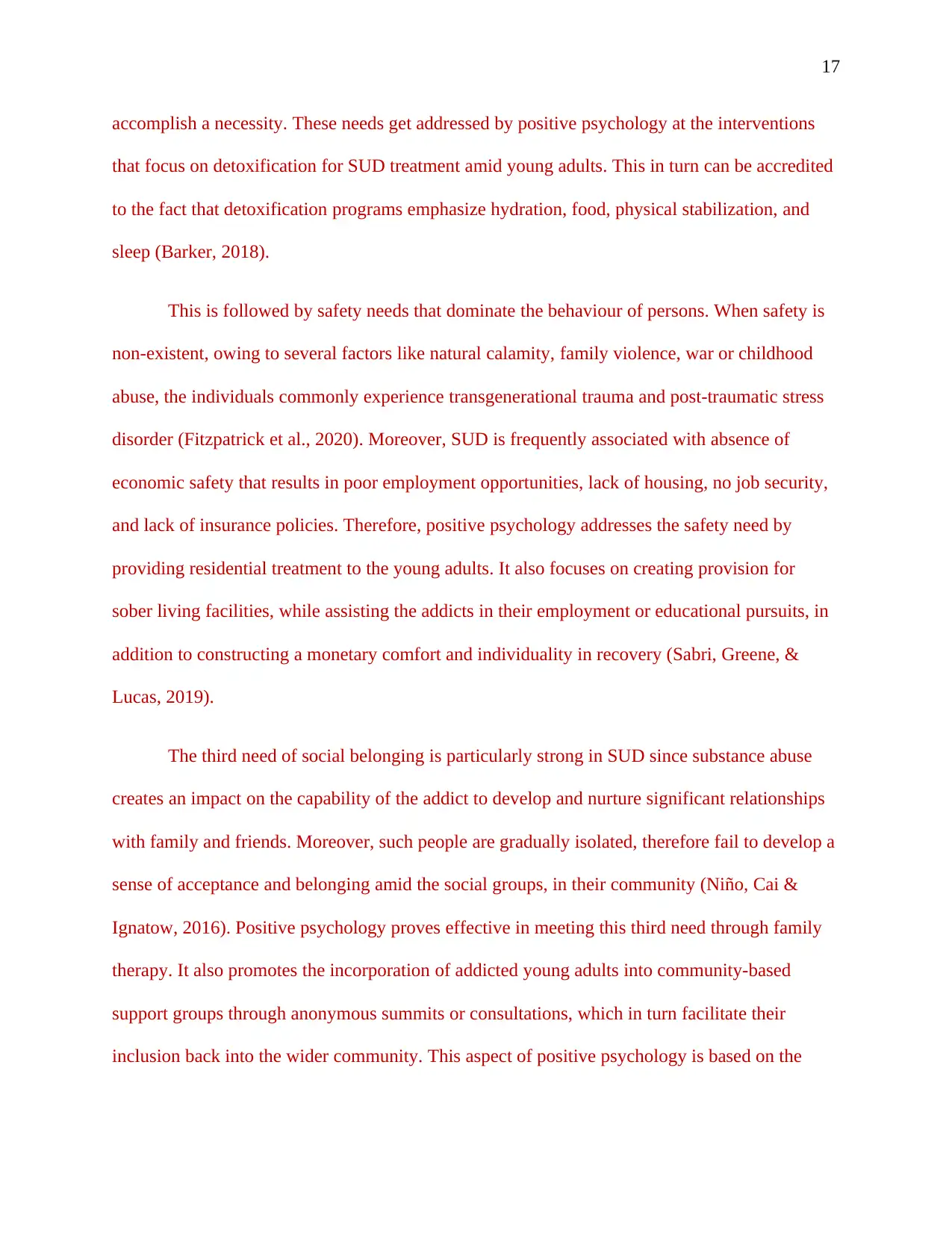
17
accomplish a necessity. These needs get addressed by positive psychology at the interventions
that focus on detoxification for SUD treatment amid young adults. This in turn can be accredited
to the fact that detoxification programs emphasize hydration, food, physical stabilization, and
sleep (Barker, 2018).
This is followed by safety needs that dominate the behaviour of persons. When safety is
non-existent, owing to several factors like natural calamity, family violence, war or childhood
abuse, the individuals commonly experience transgenerational trauma and post-traumatic stress
disorder (Fitzpatrick et al., 2020). Moreover, SUD is frequently associated with absence of
economic safety that results in poor employment opportunities, lack of housing, no job security,
and lack of insurance policies. Therefore, positive psychology addresses the safety need by
providing residential treatment to the young adults. It also focuses on creating provision for
sober living facilities, while assisting the addicts in their employment or educational pursuits, in
addition to constructing a monetary comfort and individuality in recovery (Sabri, Greene, &
Lucas, 2019).
The third need of social belonging is particularly strong in SUD since substance abuse
creates an impact on the capability of the addict to develop and nurture significant relationships
with family and friends. Moreover, such people are gradually isolated, therefore fail to develop a
sense of acceptance and belonging amid the social groups, in their community (Niño, Cai &
Ignatow, 2016). Positive psychology proves effective in meeting this third need through family
therapy. It also promotes the incorporation of addicted young adults into community-based
support groups through anonymous summits or consultations, which in turn facilitate their
inclusion back into the wider community. This aspect of positive psychology is based on the
accomplish a necessity. These needs get addressed by positive psychology at the interventions
that focus on detoxification for SUD treatment amid young adults. This in turn can be accredited
to the fact that detoxification programs emphasize hydration, food, physical stabilization, and
sleep (Barker, 2018).
This is followed by safety needs that dominate the behaviour of persons. When safety is
non-existent, owing to several factors like natural calamity, family violence, war or childhood
abuse, the individuals commonly experience transgenerational trauma and post-traumatic stress
disorder (Fitzpatrick et al., 2020). Moreover, SUD is frequently associated with absence of
economic safety that results in poor employment opportunities, lack of housing, no job security,
and lack of insurance policies. Therefore, positive psychology addresses the safety need by
providing residential treatment to the young adults. It also focuses on creating provision for
sober living facilities, while assisting the addicts in their employment or educational pursuits, in
addition to constructing a monetary comfort and individuality in recovery (Sabri, Greene, &
Lucas, 2019).
The third need of social belonging is particularly strong in SUD since substance abuse
creates an impact on the capability of the addict to develop and nurture significant relationships
with family and friends. Moreover, such people are gradually isolated, therefore fail to develop a
sense of acceptance and belonging amid the social groups, in their community (Niño, Cai &
Ignatow, 2016). Positive psychology proves effective in meeting this third need through family
therapy. It also promotes the incorporation of addicted young adults into community-based
support groups through anonymous summits or consultations, which in turn facilitate their
inclusion back into the wider community. This aspect of positive psychology is based on the
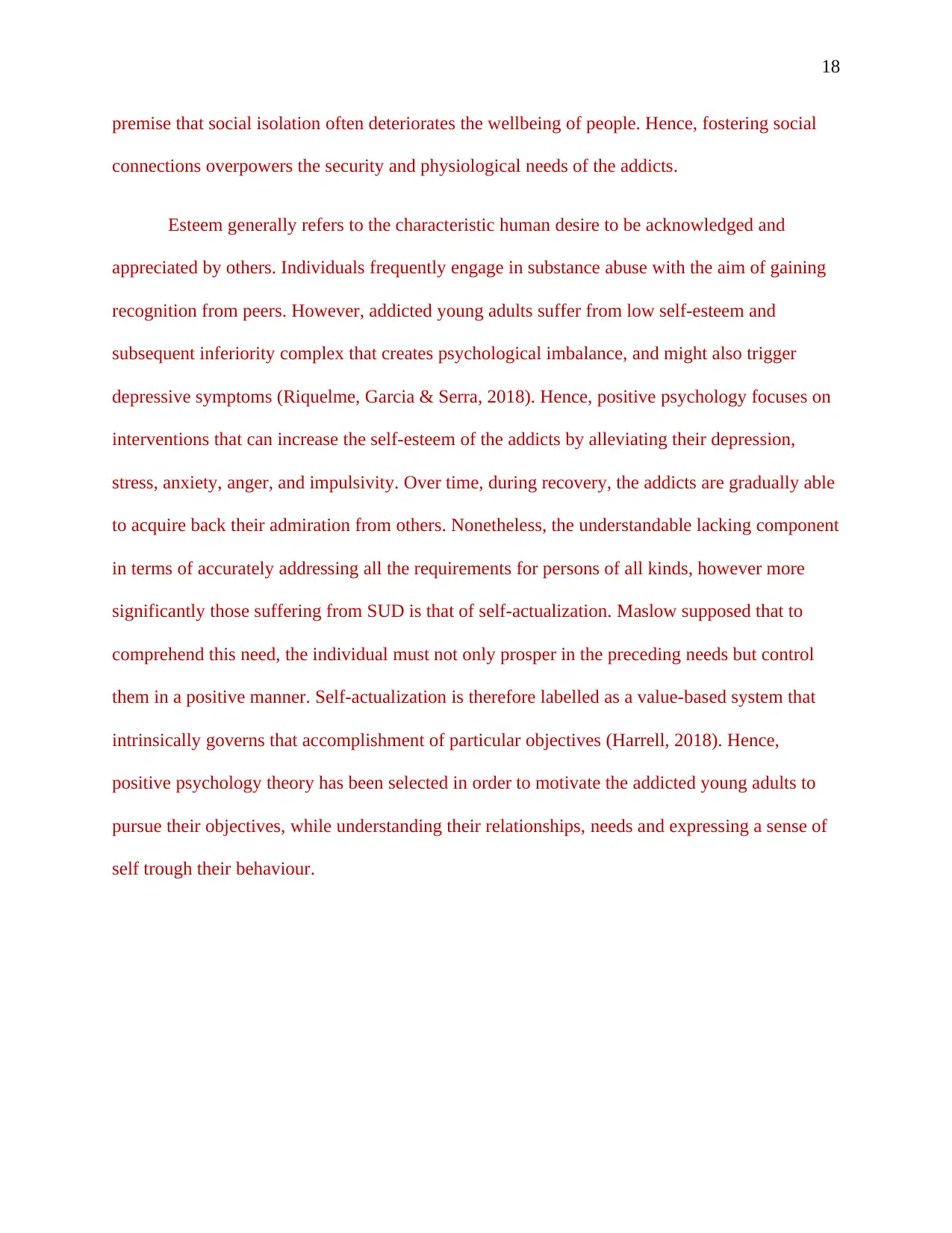
18
premise that social isolation often deteriorates the wellbeing of people. Hence, fostering social
connections overpowers the security and physiological needs of the addicts.
Esteem generally refers to the characteristic human desire to be acknowledged and
appreciated by others. Individuals frequently engage in substance abuse with the aim of gaining
recognition from peers. However, addicted young adults suffer from low self-esteem and
subsequent inferiority complex that creates psychological imbalance, and might also trigger
depressive symptoms (Riquelme, Garcia & Serra, 2018). Hence, positive psychology focuses on
interventions that can increase the self-esteem of the addicts by alleviating their depression,
stress, anxiety, anger, and impulsivity. Over time, during recovery, the addicts are gradually able
to acquire back their admiration from others. Nonetheless, the understandable lacking component
in terms of accurately addressing all the requirements for persons of all kinds, however more
significantly those suffering from SUD is that of self-actualization. Maslow supposed that to
comprehend this need, the individual must not only prosper in the preceding needs but control
them in a positive manner. Self-actualization is therefore labelled as a value-based system that
intrinsically governs that accomplishment of particular objectives (Harrell, 2018). Hence,
positive psychology theory has been selected in order to motivate the addicted young adults to
pursue their objectives, while understanding their relationships, needs and expressing a sense of
self trough their behaviour.
premise that social isolation often deteriorates the wellbeing of people. Hence, fostering social
connections overpowers the security and physiological needs of the addicts.
Esteem generally refers to the characteristic human desire to be acknowledged and
appreciated by others. Individuals frequently engage in substance abuse with the aim of gaining
recognition from peers. However, addicted young adults suffer from low self-esteem and
subsequent inferiority complex that creates psychological imbalance, and might also trigger
depressive symptoms (Riquelme, Garcia & Serra, 2018). Hence, positive psychology focuses on
interventions that can increase the self-esteem of the addicts by alleviating their depression,
stress, anxiety, anger, and impulsivity. Over time, during recovery, the addicts are gradually able
to acquire back their admiration from others. Nonetheless, the understandable lacking component
in terms of accurately addressing all the requirements for persons of all kinds, however more
significantly those suffering from SUD is that of self-actualization. Maslow supposed that to
comprehend this need, the individual must not only prosper in the preceding needs but control
them in a positive manner. Self-actualization is therefore labelled as a value-based system that
intrinsically governs that accomplishment of particular objectives (Harrell, 2018). Hence,
positive psychology theory has been selected in order to motivate the addicted young adults to
pursue their objectives, while understanding their relationships, needs and expressing a sense of
self trough their behaviour.
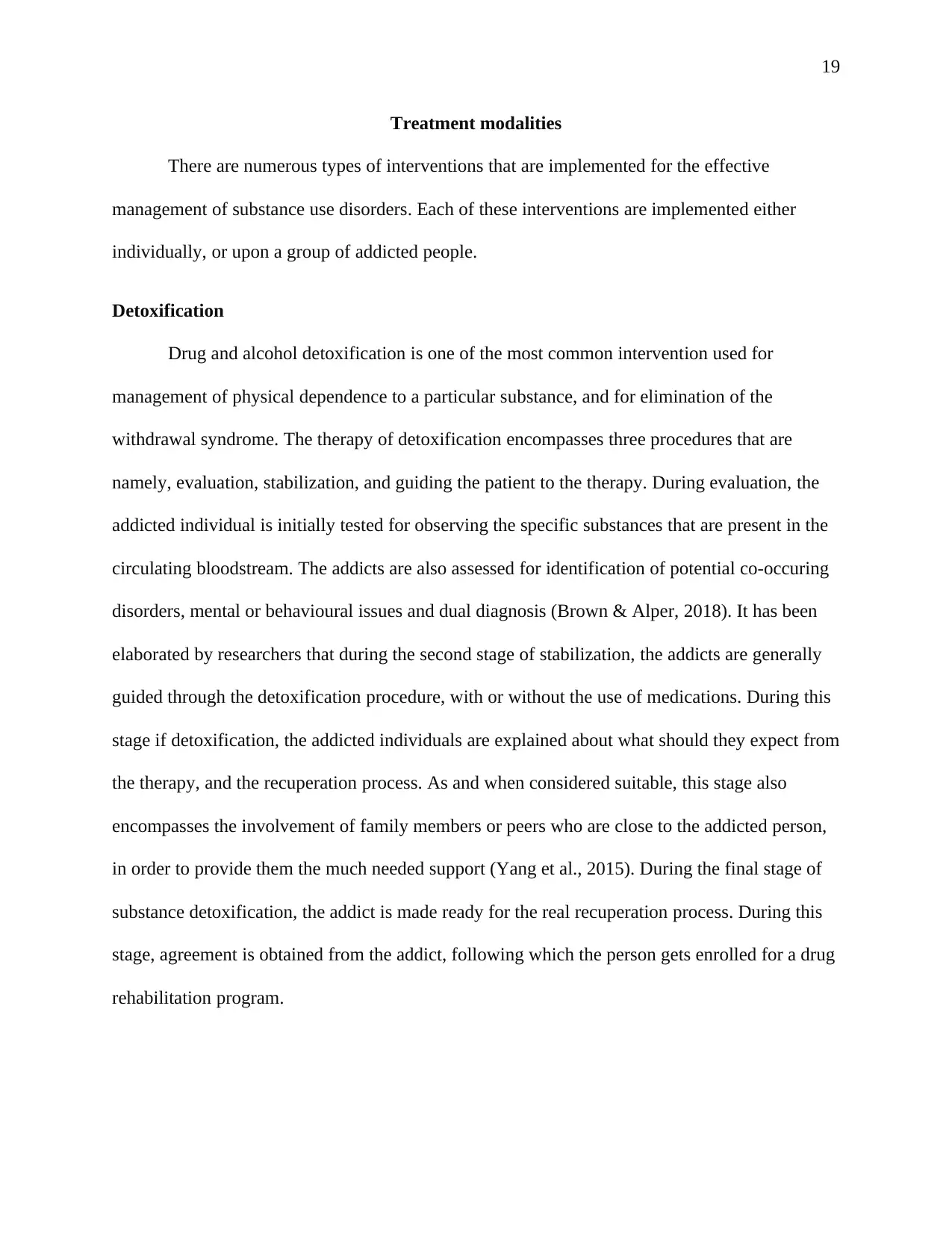
19
Treatment modalities
There are numerous types of interventions that are implemented for the effective
management of substance use disorders. Each of these interventions are implemented either
individually, or upon a group of addicted people.
Detoxification
Drug and alcohol detoxification is one of the most common intervention used for
management of physical dependence to a particular substance, and for elimination of the
withdrawal syndrome. The therapy of detoxification encompasses three procedures that are
namely, evaluation, stabilization, and guiding the patient to the therapy. During evaluation, the
addicted individual is initially tested for observing the specific substances that are present in the
circulating bloodstream. The addicts are also assessed for identification of potential co-occuring
disorders, mental or behavioural issues and dual diagnosis (Brown & Alper, 2018). It has been
elaborated by researchers that during the second stage of stabilization, the addicts are generally
guided through the detoxification procedure, with or without the use of medications. During this
stage if detoxification, the addicted individuals are explained about what should they expect from
the therapy, and the recuperation process. As and when considered suitable, this stage also
encompasses the involvement of family members or peers who are close to the addicted person,
in order to provide them the much needed support (Yang et al., 2015). During the final stage of
substance detoxification, the addict is made ready for the real recuperation process. During this
stage, agreement is obtained from the addict, following which the person gets enrolled for a drug
rehabilitation program.
Treatment modalities
There are numerous types of interventions that are implemented for the effective
management of substance use disorders. Each of these interventions are implemented either
individually, or upon a group of addicted people.
Detoxification
Drug and alcohol detoxification is one of the most common intervention used for
management of physical dependence to a particular substance, and for elimination of the
withdrawal syndrome. The therapy of detoxification encompasses three procedures that are
namely, evaluation, stabilization, and guiding the patient to the therapy. During evaluation, the
addicted individual is initially tested for observing the specific substances that are present in the
circulating bloodstream. The addicts are also assessed for identification of potential co-occuring
disorders, mental or behavioural issues and dual diagnosis (Brown & Alper, 2018). It has been
elaborated by researchers that during the second stage of stabilization, the addicts are generally
guided through the detoxification procedure, with or without the use of medications. During this
stage if detoxification, the addicted individuals are explained about what should they expect from
the therapy, and the recuperation process. As and when considered suitable, this stage also
encompasses the involvement of family members or peers who are close to the addicted person,
in order to provide them the much needed support (Yang et al., 2015). During the final stage of
substance detoxification, the addict is made ready for the real recuperation process. During this
stage, agreement is obtained from the addict, following which the person gets enrolled for a drug
rehabilitation program.
Paraphrase This Document
Need a fresh take? Get an instant paraphrase of this document with our AI Paraphraser
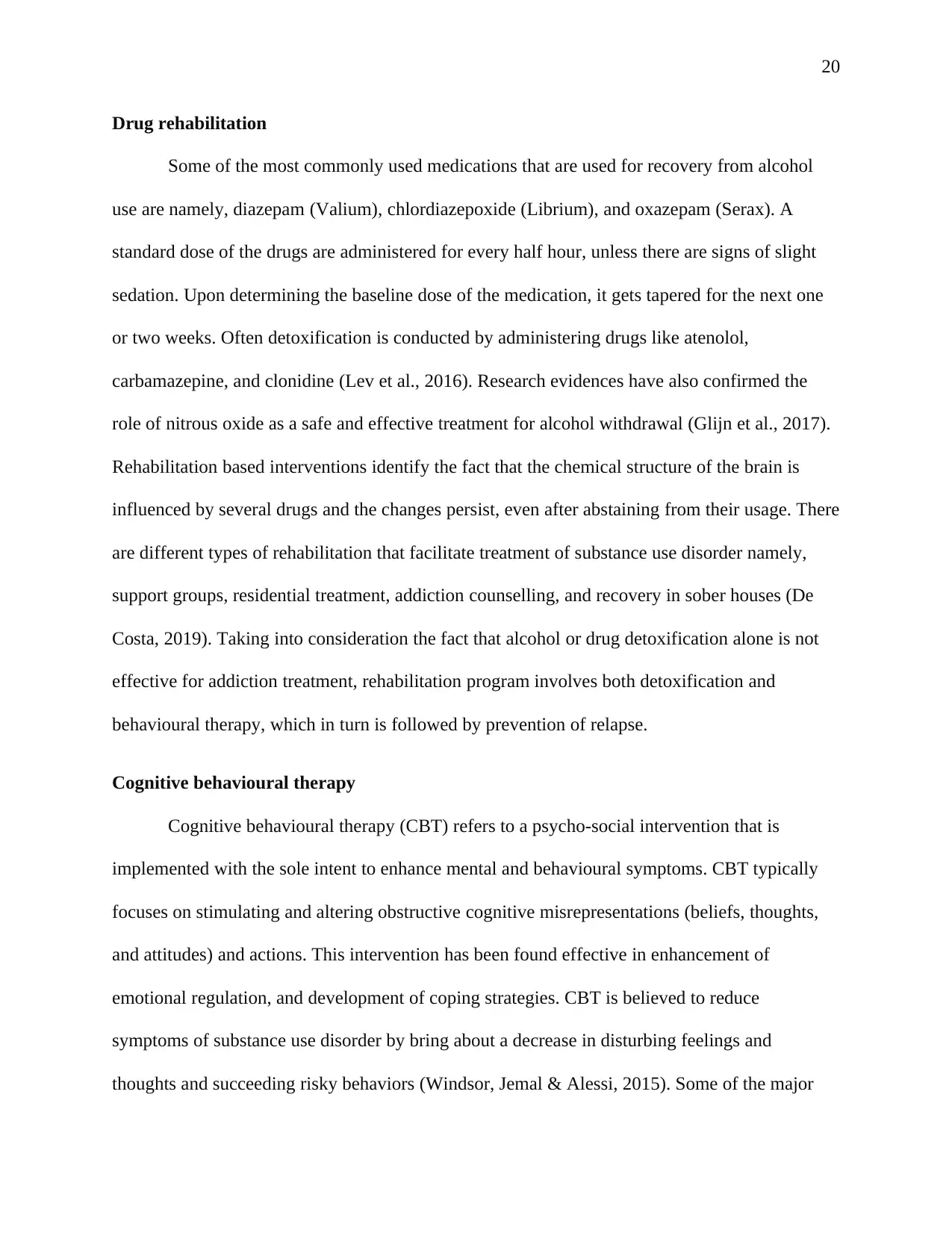
20
Drug rehabilitation
Some of the most commonly used medications that are used for recovery from alcohol
use are namely, diazepam (Valium), chlordiazepoxide (Librium), and oxazepam (Serax). A
standard dose of the drugs are administered for every half hour, unless there are signs of slight
sedation. Upon determining the baseline dose of the medication, it gets tapered for the next one
or two weeks. Often detoxification is conducted by administering drugs like atenolol,
carbamazepine, and clonidine (Lev et al., 2016). Research evidences have also confirmed the
role of nitrous oxide as a safe and effective treatment for alcohol withdrawal (Glijn et al., 2017).
Rehabilitation based interventions identify the fact that the chemical structure of the brain is
influenced by several drugs and the changes persist, even after abstaining from their usage. There
are different types of rehabilitation that facilitate treatment of substance use disorder namely,
support groups, residential treatment, addiction counselling, and recovery in sober houses (De
Costa, 2019). Taking into consideration the fact that alcohol or drug detoxification alone is not
effective for addiction treatment, rehabilitation program involves both detoxification and
behavioural therapy, which in turn is followed by prevention of relapse.
Cognitive behavioural therapy
Cognitive behavioural therapy (CBT) refers to a psycho-social intervention that is
implemented with the sole intent to enhance mental and behavioural symptoms. CBT typically
focuses on stimulating and altering obstructive cognitive misrepresentations (beliefs, thoughts,
and attitudes) and actions. This intervention has been found effective in enhancement of
emotional regulation, and development of coping strategies. CBT is believed to reduce
symptoms of substance use disorder by bring about a decrease in disturbing feelings and
thoughts and succeeding risky behaviors (Windsor, Jemal & Alessi, 2015). Some of the major
Drug rehabilitation
Some of the most commonly used medications that are used for recovery from alcohol
use are namely, diazepam (Valium), chlordiazepoxide (Librium), and oxazepam (Serax). A
standard dose of the drugs are administered for every half hour, unless there are signs of slight
sedation. Upon determining the baseline dose of the medication, it gets tapered for the next one
or two weeks. Often detoxification is conducted by administering drugs like atenolol,
carbamazepine, and clonidine (Lev et al., 2016). Research evidences have also confirmed the
role of nitrous oxide as a safe and effective treatment for alcohol withdrawal (Glijn et al., 2017).
Rehabilitation based interventions identify the fact that the chemical structure of the brain is
influenced by several drugs and the changes persist, even after abstaining from their usage. There
are different types of rehabilitation that facilitate treatment of substance use disorder namely,
support groups, residential treatment, addiction counselling, and recovery in sober houses (De
Costa, 2019). Taking into consideration the fact that alcohol or drug detoxification alone is not
effective for addiction treatment, rehabilitation program involves both detoxification and
behavioural therapy, which in turn is followed by prevention of relapse.
Cognitive behavioural therapy
Cognitive behavioural therapy (CBT) refers to a psycho-social intervention that is
implemented with the sole intent to enhance mental and behavioural symptoms. CBT typically
focuses on stimulating and altering obstructive cognitive misrepresentations (beliefs, thoughts,
and attitudes) and actions. This intervention has been found effective in enhancement of
emotional regulation, and development of coping strategies. CBT is believed to reduce
symptoms of substance use disorder by bring about a decrease in disturbing feelings and
thoughts and succeeding risky behaviors (Windsor, Jemal & Alessi, 2015). Some of the major
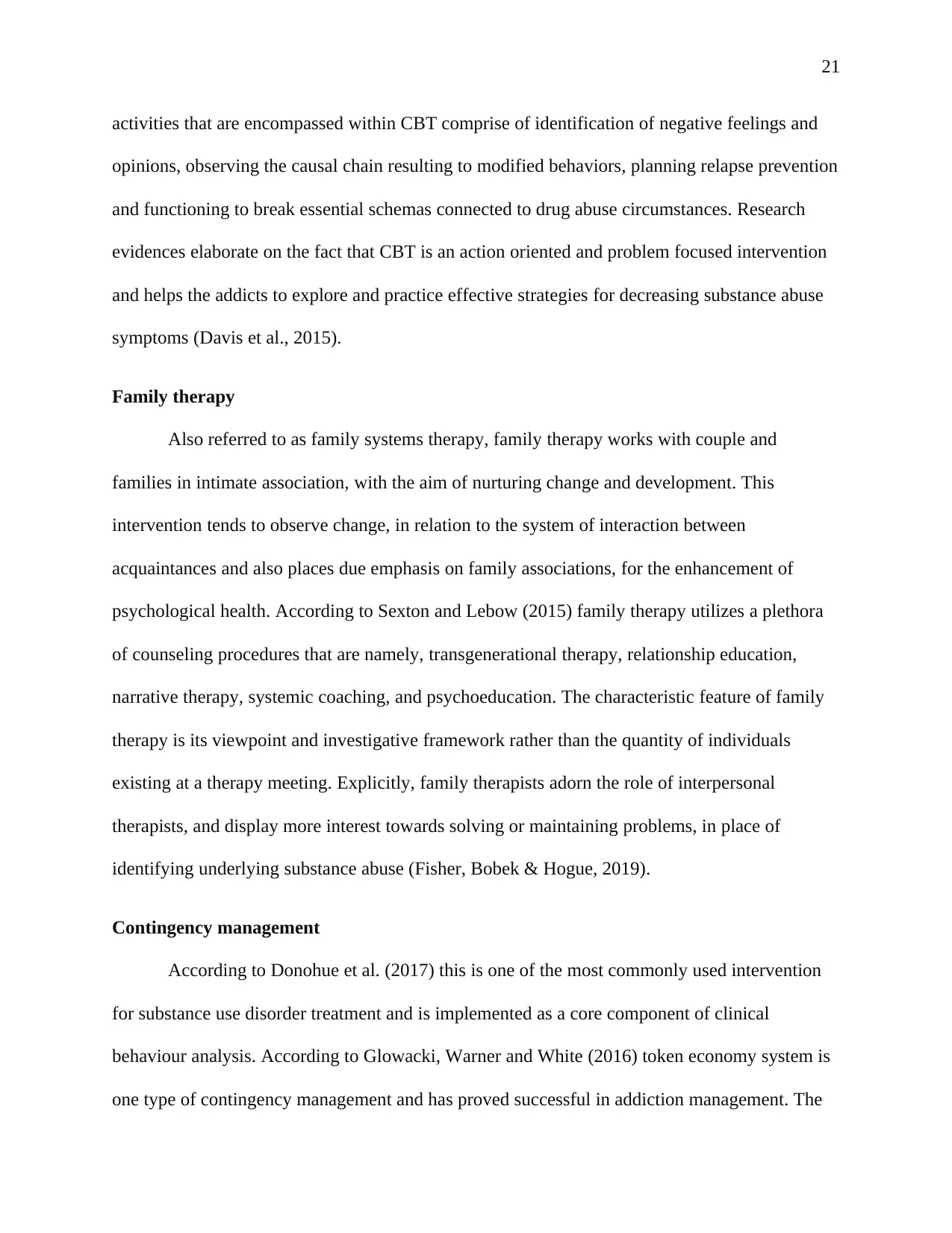
21
activities that are encompassed within CBT comprise of identification of negative feelings and
opinions, observing the causal chain resulting to modified behaviors, planning relapse prevention
and functioning to break essential schemas connected to drug abuse circumstances. Research
evidences elaborate on the fact that CBT is an action oriented and problem focused intervention
and helps the addicts to explore and practice effective strategies for decreasing substance abuse
symptoms (Davis et al., 2015).
Family therapy
Also referred to as family systems therapy, family therapy works with couple and
families in intimate association, with the aim of nurturing change and development. This
intervention tends to observe change, in relation to the system of interaction between
acquaintances and also places due emphasis on family associations, for the enhancement of
psychological health. According to Sexton and Lebow (2015) family therapy utilizes a plethora
of counseling procedures that are namely, transgenerational therapy, relationship education,
narrative therapy, systemic coaching, and psychoeducation. The characteristic feature of family
therapy is its viewpoint and investigative framework rather than the quantity of individuals
existing at a therapy meeting. Explicitly, family therapists adorn the role of interpersonal
therapists, and display more interest towards solving or maintaining problems, in place of
identifying underlying substance abuse (Fisher, Bobek & Hogue, 2019).
Contingency management
According to Donohue et al. (2017) this is one of the most commonly used intervention
for substance use disorder treatment and is implemented as a core component of clinical
behaviour analysis. According to Glowacki, Warner and White (2016) token economy system is
one type of contingency management and has proved successful in addiction management. The
activities that are encompassed within CBT comprise of identification of negative feelings and
opinions, observing the causal chain resulting to modified behaviors, planning relapse prevention
and functioning to break essential schemas connected to drug abuse circumstances. Research
evidences elaborate on the fact that CBT is an action oriented and problem focused intervention
and helps the addicts to explore and practice effective strategies for decreasing substance abuse
symptoms (Davis et al., 2015).
Family therapy
Also referred to as family systems therapy, family therapy works with couple and
families in intimate association, with the aim of nurturing change and development. This
intervention tends to observe change, in relation to the system of interaction between
acquaintances and also places due emphasis on family associations, for the enhancement of
psychological health. According to Sexton and Lebow (2015) family therapy utilizes a plethora
of counseling procedures that are namely, transgenerational therapy, relationship education,
narrative therapy, systemic coaching, and psychoeducation. The characteristic feature of family
therapy is its viewpoint and investigative framework rather than the quantity of individuals
existing at a therapy meeting. Explicitly, family therapists adorn the role of interpersonal
therapists, and display more interest towards solving or maintaining problems, in place of
identifying underlying substance abuse (Fisher, Bobek & Hogue, 2019).
Contingency management
According to Donohue et al. (2017) this is one of the most commonly used intervention
for substance use disorder treatment and is implemented as a core component of clinical
behaviour analysis. According to Glowacki, Warner and White (2016) token economy system is
one type of contingency management and has proved successful in addiction management. The
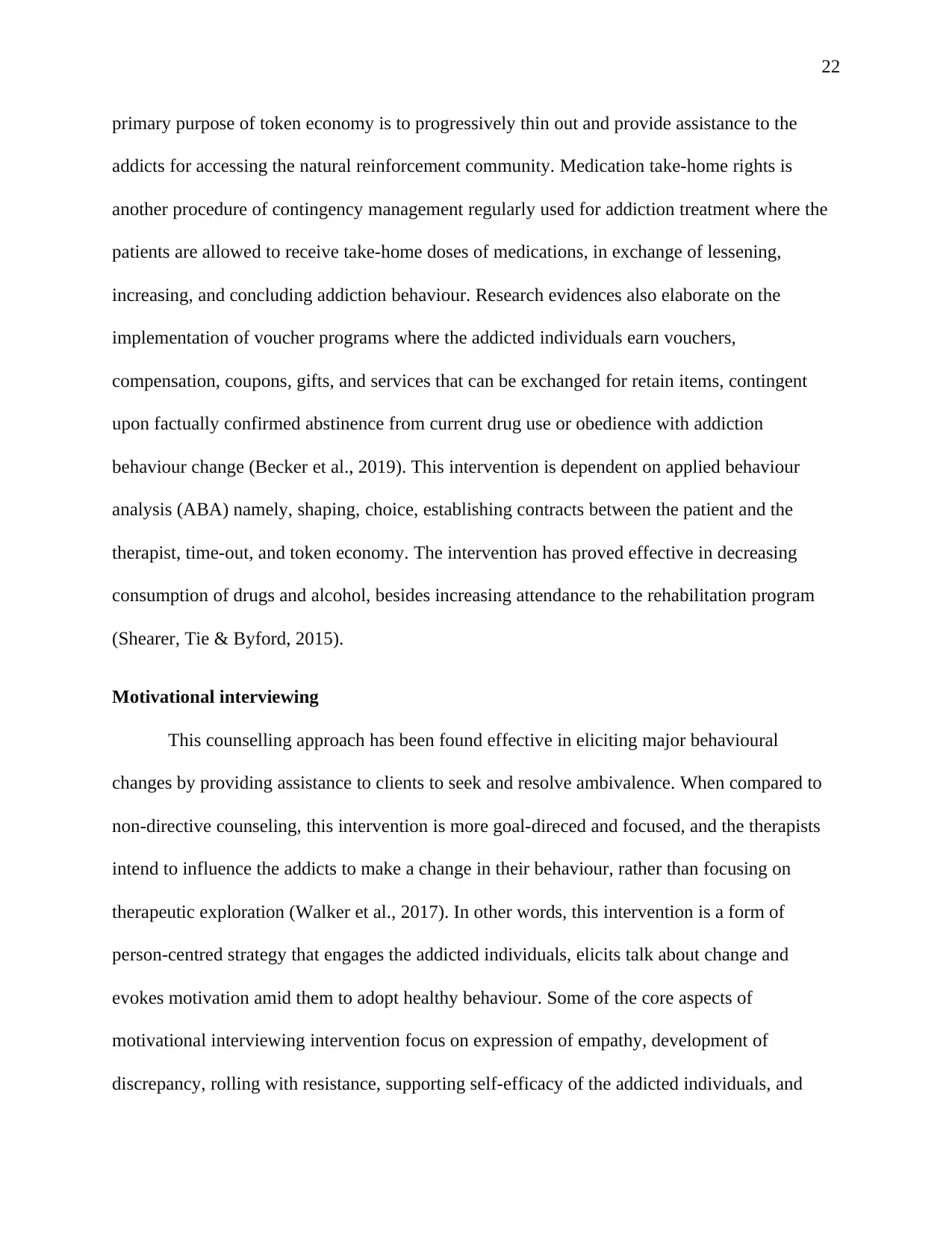
22
primary purpose of token economy is to progressively thin out and provide assistance to the
addicts for accessing the natural reinforcement community. Medication take-home rights is
another procedure of contingency management regularly used for addiction treatment where the
patients are allowed to receive take-home doses of medications, in exchange of lessening,
increasing, and concluding addiction behaviour. Research evidences also elaborate on the
implementation of voucher programs where the addicted individuals earn vouchers,
compensation, coupons, gifts, and services that can be exchanged for retain items, contingent
upon factually confirmed abstinence from current drug use or obedience with addiction
behaviour change (Becker et al., 2019). This intervention is dependent on applied behaviour
analysis (ABA) namely, shaping, choice, establishing contracts between the patient and the
therapist, time-out, and token economy. The intervention has proved effective in decreasing
consumption of drugs and alcohol, besides increasing attendance to the rehabilitation program
(Shearer, Tie & Byford, 2015).
Motivational interviewing
This counselling approach has been found effective in eliciting major behavioural
changes by providing assistance to clients to seek and resolve ambivalence. When compared to
non-directive counseling, this intervention is more goal-direced and focused, and the therapists
intend to influence the addicts to make a change in their behaviour, rather than focusing on
therapeutic exploration (Walker et al., 2017). In other words, this intervention is a form of
person-centred strategy that engages the addicted individuals, elicits talk about change and
evokes motivation amid them to adopt healthy behaviour. Some of the core aspects of
motivational interviewing intervention focus on expression of empathy, development of
discrepancy, rolling with resistance, supporting self-efficacy of the addicted individuals, and
primary purpose of token economy is to progressively thin out and provide assistance to the
addicts for accessing the natural reinforcement community. Medication take-home rights is
another procedure of contingency management regularly used for addiction treatment where the
patients are allowed to receive take-home doses of medications, in exchange of lessening,
increasing, and concluding addiction behaviour. Research evidences also elaborate on the
implementation of voucher programs where the addicted individuals earn vouchers,
compensation, coupons, gifts, and services that can be exchanged for retain items, contingent
upon factually confirmed abstinence from current drug use or obedience with addiction
behaviour change (Becker et al., 2019). This intervention is dependent on applied behaviour
analysis (ABA) namely, shaping, choice, establishing contracts between the patient and the
therapist, time-out, and token economy. The intervention has proved effective in decreasing
consumption of drugs and alcohol, besides increasing attendance to the rehabilitation program
(Shearer, Tie & Byford, 2015).
Motivational interviewing
This counselling approach has been found effective in eliciting major behavioural
changes by providing assistance to clients to seek and resolve ambivalence. When compared to
non-directive counseling, this intervention is more goal-direced and focused, and the therapists
intend to influence the addicts to make a change in their behaviour, rather than focusing on
therapeutic exploration (Walker et al., 2017). In other words, this intervention is a form of
person-centred strategy that engages the addicted individuals, elicits talk about change and
evokes motivation amid them to adopt healthy behaviour. Some of the core aspects of
motivational interviewing intervention focus on expression of empathy, development of
discrepancy, rolling with resistance, supporting self-efficacy of the addicted individuals, and
Secure Best Marks with AI Grader
Need help grading? Try our AI Grader for instant feedback on your assignments.
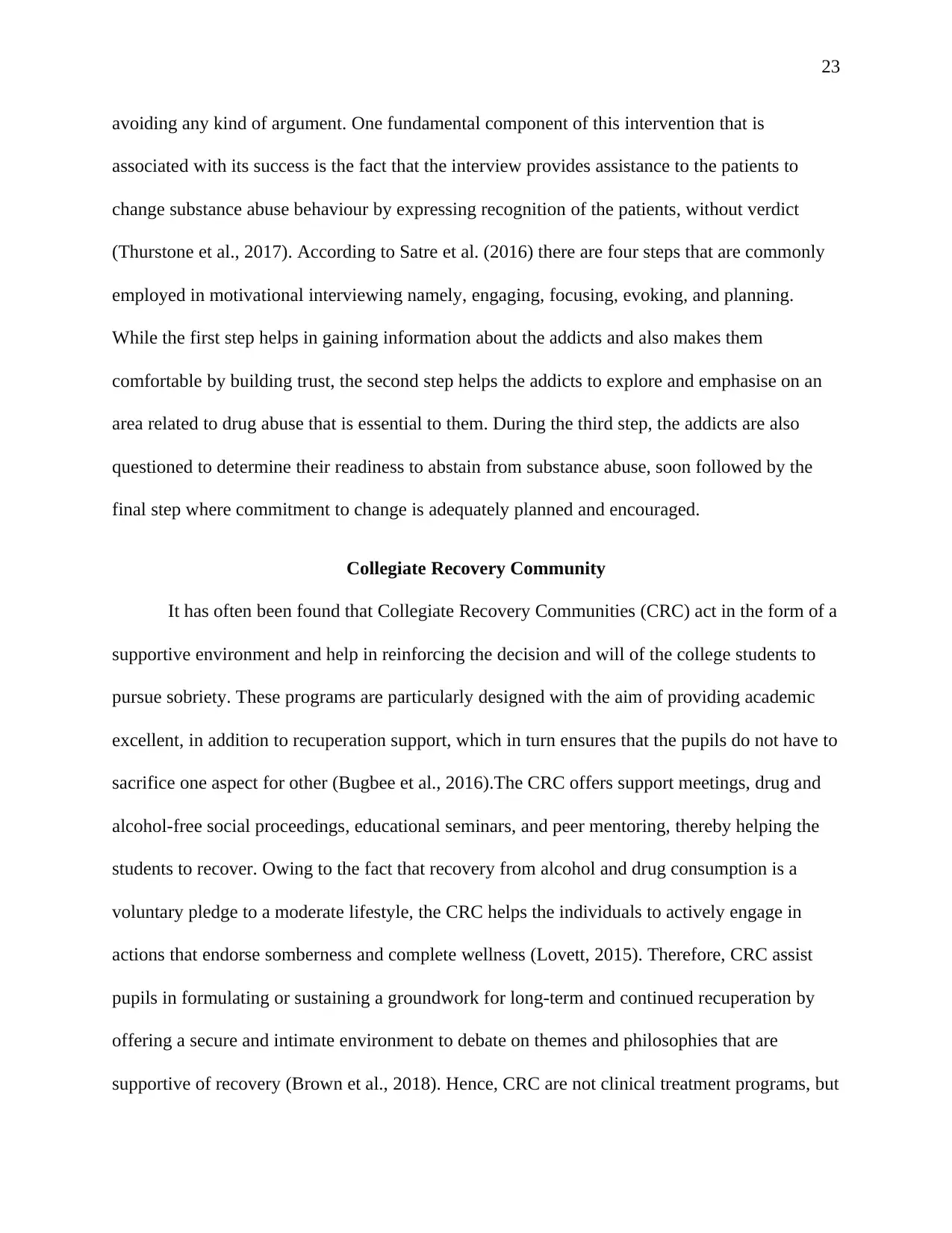
23
avoiding any kind of argument. One fundamental component of this intervention that is
associated with its success is the fact that the interview provides assistance to the patients to
change substance abuse behaviour by expressing recognition of the patients, without verdict
(Thurstone et al., 2017). According to Satre et al. (2016) there are four steps that are commonly
employed in motivational interviewing namely, engaging, focusing, evoking, and planning.
While the first step helps in gaining information about the addicts and also makes them
comfortable by building trust, the second step helps the addicts to explore and emphasise on an
area related to drug abuse that is essential to them. During the third step, the addicts are also
questioned to determine their readiness to abstain from substance abuse, soon followed by the
final step where commitment to change is adequately planned and encouraged.
Collegiate Recovery Community
It has often been found that Collegiate Recovery Communities (CRC) act in the form of a
supportive environment and help in reinforcing the decision and will of the college students to
pursue sobriety. These programs are particularly designed with the aim of providing academic
excellent, in addition to recuperation support, which in turn ensures that the pupils do not have to
sacrifice one aspect for other (Bugbee et al., 2016).The CRC offers support meetings, drug and
alcohol-free social proceedings, educational seminars, and peer mentoring, thereby helping the
students to recover. Owing to the fact that recovery from alcohol and drug consumption is a
voluntary pledge to a moderate lifestyle, the CRC helps the individuals to actively engage in
actions that endorse somberness and complete wellness (Lovett, 2015). Therefore, CRC assist
pupils in formulating or sustaining a groundwork for long-term and continued recuperation by
offering a secure and intimate environment to debate on themes and philosophies that are
supportive of recovery (Brown et al., 2018). Hence, CRC are not clinical treatment programs, but
avoiding any kind of argument. One fundamental component of this intervention that is
associated with its success is the fact that the interview provides assistance to the patients to
change substance abuse behaviour by expressing recognition of the patients, without verdict
(Thurstone et al., 2017). According to Satre et al. (2016) there are four steps that are commonly
employed in motivational interviewing namely, engaging, focusing, evoking, and planning.
While the first step helps in gaining information about the addicts and also makes them
comfortable by building trust, the second step helps the addicts to explore and emphasise on an
area related to drug abuse that is essential to them. During the third step, the addicts are also
questioned to determine their readiness to abstain from substance abuse, soon followed by the
final step where commitment to change is adequately planned and encouraged.
Collegiate Recovery Community
It has often been found that Collegiate Recovery Communities (CRC) act in the form of a
supportive environment and help in reinforcing the decision and will of the college students to
pursue sobriety. These programs are particularly designed with the aim of providing academic
excellent, in addition to recuperation support, which in turn ensures that the pupils do not have to
sacrifice one aspect for other (Bugbee et al., 2016).The CRC offers support meetings, drug and
alcohol-free social proceedings, educational seminars, and peer mentoring, thereby helping the
students to recover. Owing to the fact that recovery from alcohol and drug consumption is a
voluntary pledge to a moderate lifestyle, the CRC helps the individuals to actively engage in
actions that endorse somberness and complete wellness (Lovett, 2015). Therefore, CRC assist
pupils in formulating or sustaining a groundwork for long-term and continued recuperation by
offering a secure and intimate environment to debate on themes and philosophies that are
supportive of recovery (Brown et al., 2018). Hence, CRC are not clinical treatment programs, but
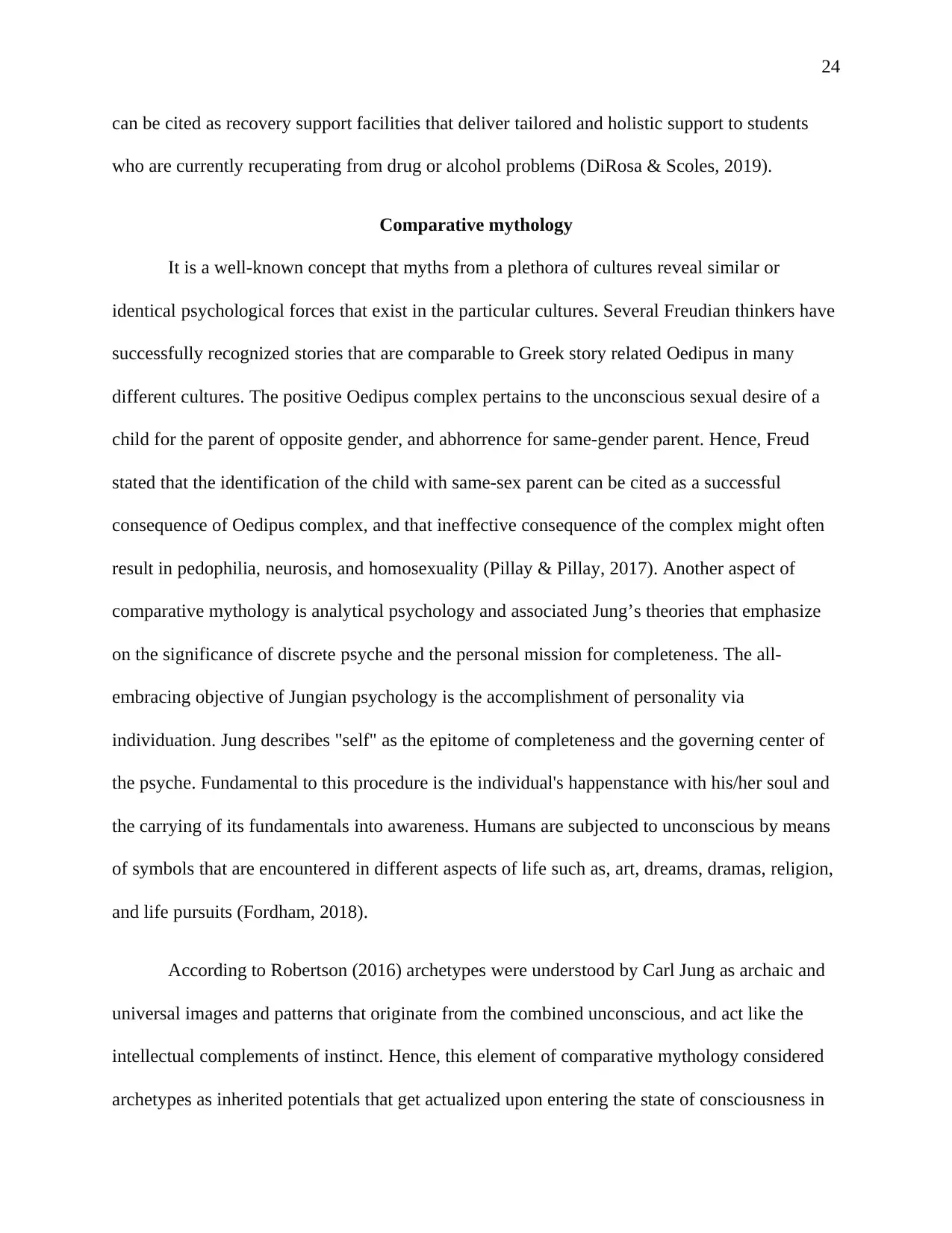
24
can be cited as recovery support facilities that deliver tailored and holistic support to students
who are currently recuperating from drug or alcohol problems (DiRosa & Scoles, 2019).
Comparative mythology
It is a well-known concept that myths from a plethora of cultures reveal similar or
identical psychological forces that exist in the particular cultures. Several Freudian thinkers have
successfully recognized stories that are comparable to Greek story related Oedipus in many
different cultures. The positive Oedipus complex pertains to the unconscious sexual desire of a
child for the parent of opposite gender, and abhorrence for same-gender parent. Hence, Freud
stated that the identification of the child with same-sex parent can be cited as a successful
consequence of Oedipus complex, and that ineffective consequence of the complex might often
result in pedophilia, neurosis, and homosexuality (Pillay & Pillay, 2017). Another aspect of
comparative mythology is analytical psychology and associated Jung’s theories that emphasize
on the significance of discrete psyche and the personal mission for completeness. The all-
embracing objective of Jungian psychology is the accomplishment of personality via
individuation. Jung describes "self" as the epitome of completeness and the governing center of
the psyche. Fundamental to this procedure is the individual's happenstance with his/her soul and
the carrying of its fundamentals into awareness. Humans are subjected to unconscious by means
of symbols that are encountered in different aspects of life such as, art, dreams, dramas, religion,
and life pursuits (Fordham, 2018).
According to Robertson (2016) archetypes were understood by Carl Jung as archaic and
universal images and patterns that originate from the combined unconscious, and act like the
intellectual complements of instinct. Hence, this element of comparative mythology considered
archetypes as inherited potentials that get actualized upon entering the state of consciousness in
can be cited as recovery support facilities that deliver tailored and holistic support to students
who are currently recuperating from drug or alcohol problems (DiRosa & Scoles, 2019).
Comparative mythology
It is a well-known concept that myths from a plethora of cultures reveal similar or
identical psychological forces that exist in the particular cultures. Several Freudian thinkers have
successfully recognized stories that are comparable to Greek story related Oedipus in many
different cultures. The positive Oedipus complex pertains to the unconscious sexual desire of a
child for the parent of opposite gender, and abhorrence for same-gender parent. Hence, Freud
stated that the identification of the child with same-sex parent can be cited as a successful
consequence of Oedipus complex, and that ineffective consequence of the complex might often
result in pedophilia, neurosis, and homosexuality (Pillay & Pillay, 2017). Another aspect of
comparative mythology is analytical psychology and associated Jung’s theories that emphasize
on the significance of discrete psyche and the personal mission for completeness. The all-
embracing objective of Jungian psychology is the accomplishment of personality via
individuation. Jung describes "self" as the epitome of completeness and the governing center of
the psyche. Fundamental to this procedure is the individual's happenstance with his/her soul and
the carrying of its fundamentals into awareness. Humans are subjected to unconscious by means
of symbols that are encountered in different aspects of life such as, art, dreams, dramas, religion,
and life pursuits (Fordham, 2018).
According to Robertson (2016) archetypes were understood by Carl Jung as archaic and
universal images and patterns that originate from the combined unconscious, and act like the
intellectual complements of instinct. Hence, this element of comparative mythology considered
archetypes as inherited potentials that get actualized upon entering the state of consciousness in
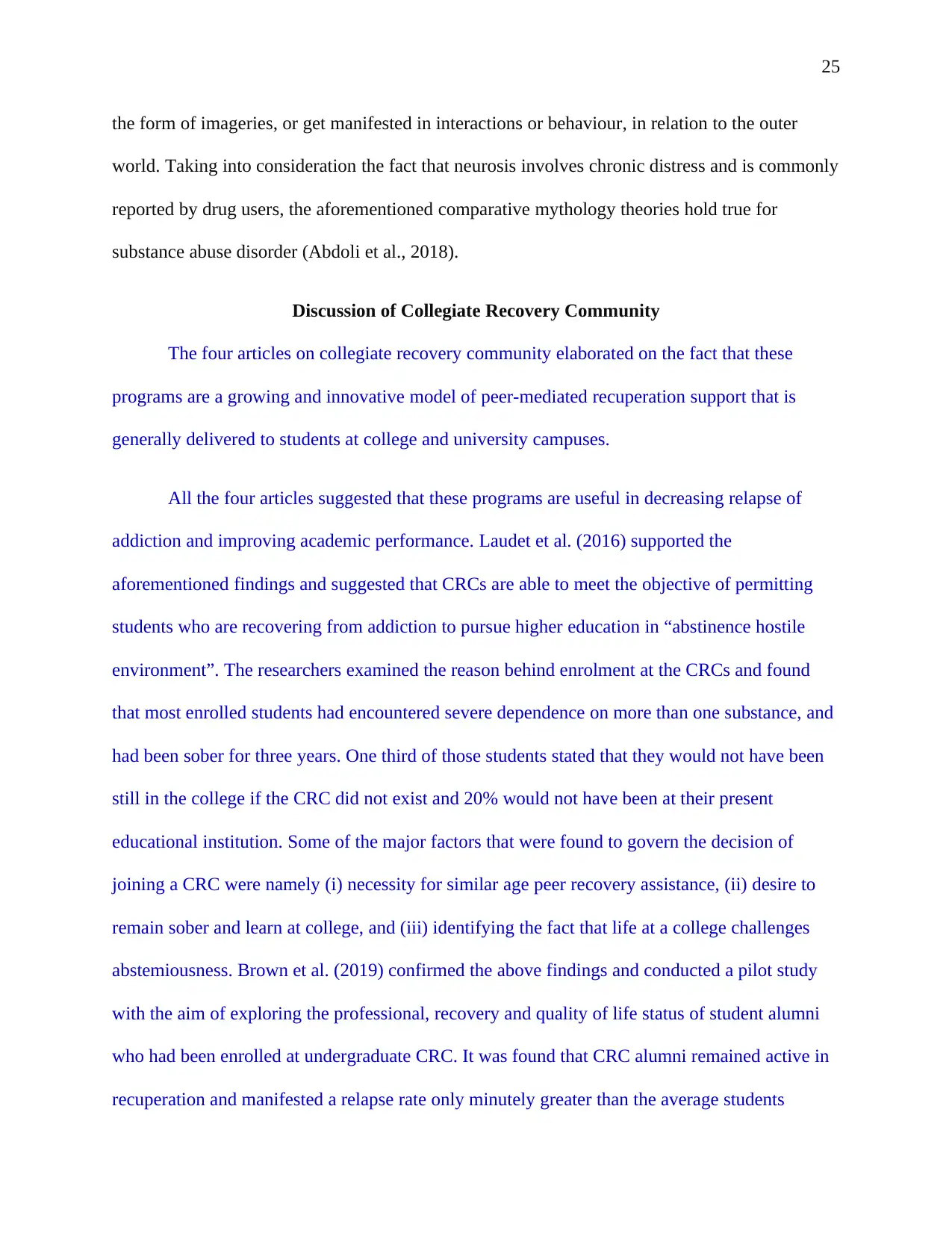
25
the form of imageries, or get manifested in interactions or behaviour, in relation to the outer
world. Taking into consideration the fact that neurosis involves chronic distress and is commonly
reported by drug users, the aforementioned comparative mythology theories hold true for
substance abuse disorder (Abdoli et al., 2018).
Discussion of Collegiate Recovery Community
The four articles on collegiate recovery community elaborated on the fact that these
programs are a growing and innovative model of peer-mediated recuperation support that is
generally delivered to students at college and university campuses.
All the four articles suggested that these programs are useful in decreasing relapse of
addiction and improving academic performance. Laudet et al. (2016) supported the
aforementioned findings and suggested that CRCs are able to meet the objective of permitting
students who are recovering from addiction to pursue higher education in “abstinence hostile
environment”. The researchers examined the reason behind enrolment at the CRCs and found
that most enrolled students had encountered severe dependence on more than one substance, and
had been sober for three years. One third of those students stated that they would not have been
still in the college if the CRC did not exist and 20% would not have been at their present
educational institution. Some of the major factors that were found to govern the decision of
joining a CRC were namely (i) necessity for similar age peer recovery assistance, (ii) desire to
remain sober and learn at college, and (iii) identifying the fact that life at a college challenges
abstemiousness. Brown et al. (2019) confirmed the above findings and conducted a pilot study
with the aim of exploring the professional, recovery and quality of life status of student alumni
who had been enrolled at undergraduate CRC. It was found that CRC alumni remained active in
recuperation and manifested a relapse rate only minutely greater than the average students
the form of imageries, or get manifested in interactions or behaviour, in relation to the outer
world. Taking into consideration the fact that neurosis involves chronic distress and is commonly
reported by drug users, the aforementioned comparative mythology theories hold true for
substance abuse disorder (Abdoli et al., 2018).
Discussion of Collegiate Recovery Community
The four articles on collegiate recovery community elaborated on the fact that these
programs are a growing and innovative model of peer-mediated recuperation support that is
generally delivered to students at college and university campuses.
All the four articles suggested that these programs are useful in decreasing relapse of
addiction and improving academic performance. Laudet et al. (2016) supported the
aforementioned findings and suggested that CRCs are able to meet the objective of permitting
students who are recovering from addiction to pursue higher education in “abstinence hostile
environment”. The researchers examined the reason behind enrolment at the CRCs and found
that most enrolled students had encountered severe dependence on more than one substance, and
had been sober for three years. One third of those students stated that they would not have been
still in the college if the CRC did not exist and 20% would not have been at their present
educational institution. Some of the major factors that were found to govern the decision of
joining a CRC were namely (i) necessity for similar age peer recovery assistance, (ii) desire to
remain sober and learn at college, and (iii) identifying the fact that life at a college challenges
abstemiousness. Brown et al. (2019) confirmed the above findings and conducted a pilot study
with the aim of exploring the professional, recovery and quality of life status of student alumni
who had been enrolled at undergraduate CRC. It was found that CRC alumni remained active in
recuperation and manifested a relapse rate only minutely greater than the average students
Paraphrase This Document
Need a fresh take? Get an instant paraphrase of this document with our AI Paraphraser
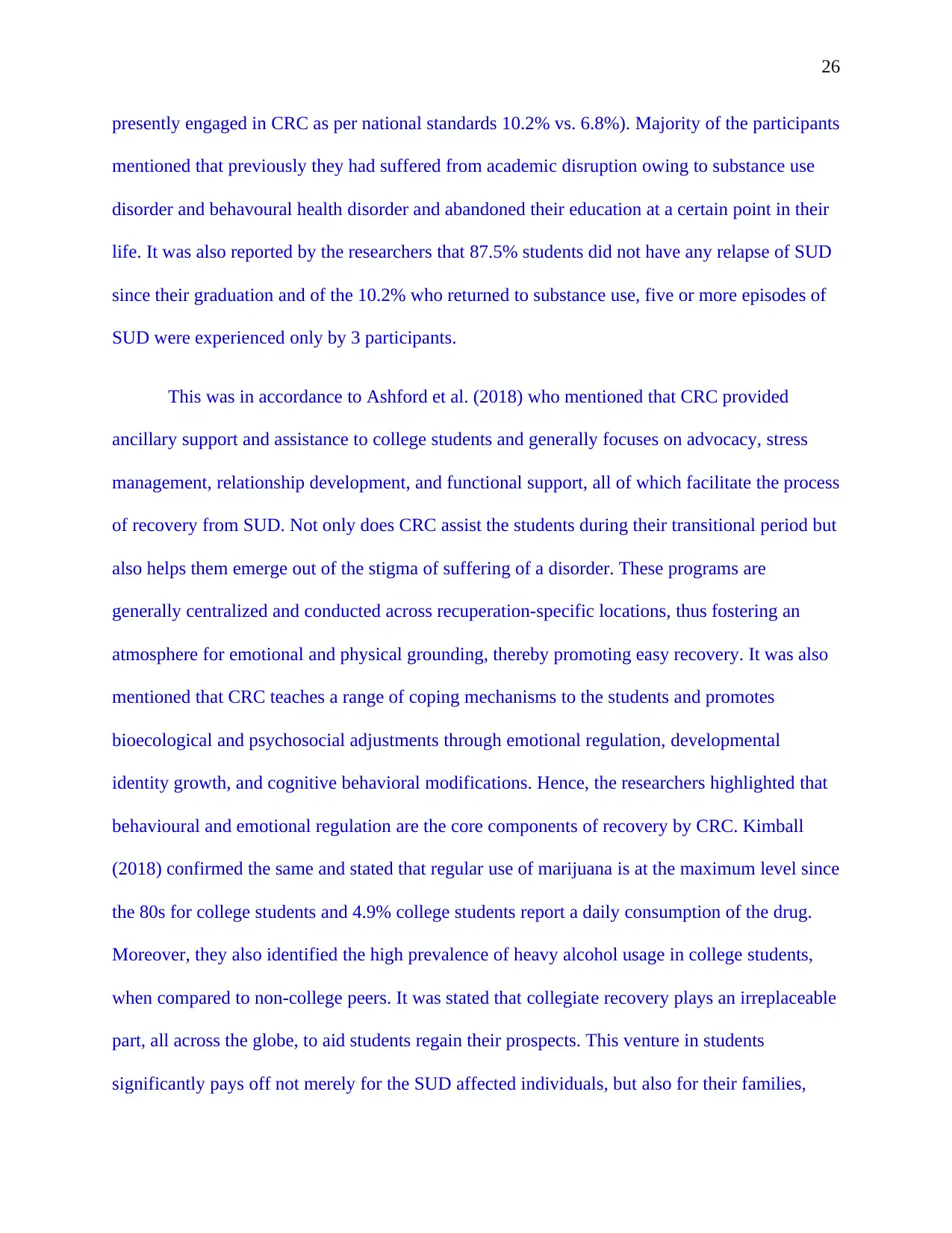
26
presently engaged in CRC as per national standards 10.2% vs. 6.8%). Majority of the participants
mentioned that previously they had suffered from academic disruption owing to substance use
disorder and behavoural health disorder and abandoned their education at a certain point in their
life. It was also reported by the researchers that 87.5% students did not have any relapse of SUD
since their graduation and of the 10.2% who returned to substance use, five or more episodes of
SUD were experienced only by 3 participants.
This was in accordance to Ashford et al. (2018) who mentioned that CRC provided
ancillary support and assistance to college students and generally focuses on advocacy, stress
management, relationship development, and functional support, all of which facilitate the process
of recovery from SUD. Not only does CRC assist the students during their transitional period but
also helps them emerge out of the stigma of suffering of a disorder. These programs are
generally centralized and conducted across recuperation-specific locations, thus fostering an
atmosphere for emotional and physical grounding, thereby promoting easy recovery. It was also
mentioned that CRC teaches a range of coping mechanisms to the students and promotes
bioecological and psychosocial adjustments through emotional regulation, developmental
identity growth, and cognitive behavioral modifications. Hence, the researchers highlighted that
behavioural and emotional regulation are the core components of recovery by CRC. Kimball
(2018) confirmed the same and stated that regular use of marijuana is at the maximum level since
the 80s for college students and 4.9% college students report a daily consumption of the drug.
Moreover, they also identified the high prevalence of heavy alcohol usage in college students,
when compared to non-college peers. It was stated that collegiate recovery plays an irreplaceable
part, all across the globe, to aid students regain their prospects. This venture in students
significantly pays off not merely for the SUD affected individuals, but also for their families,
presently engaged in CRC as per national standards 10.2% vs. 6.8%). Majority of the participants
mentioned that previously they had suffered from academic disruption owing to substance use
disorder and behavoural health disorder and abandoned their education at a certain point in their
life. It was also reported by the researchers that 87.5% students did not have any relapse of SUD
since their graduation and of the 10.2% who returned to substance use, five or more episodes of
SUD were experienced only by 3 participants.
This was in accordance to Ashford et al. (2018) who mentioned that CRC provided
ancillary support and assistance to college students and generally focuses on advocacy, stress
management, relationship development, and functional support, all of which facilitate the process
of recovery from SUD. Not only does CRC assist the students during their transitional period but
also helps them emerge out of the stigma of suffering of a disorder. These programs are
generally centralized and conducted across recuperation-specific locations, thus fostering an
atmosphere for emotional and physical grounding, thereby promoting easy recovery. It was also
mentioned that CRC teaches a range of coping mechanisms to the students and promotes
bioecological and psychosocial adjustments through emotional regulation, developmental
identity growth, and cognitive behavioral modifications. Hence, the researchers highlighted that
behavioural and emotional regulation are the core components of recovery by CRC. Kimball
(2018) confirmed the same and stated that regular use of marijuana is at the maximum level since
the 80s for college students and 4.9% college students report a daily consumption of the drug.
Moreover, they also identified the high prevalence of heavy alcohol usage in college students,
when compared to non-college peers. It was stated that collegiate recovery plays an irreplaceable
part, all across the globe, to aid students regain their prospects. This venture in students
significantly pays off not merely for the SUD affected individuals, but also for their families,
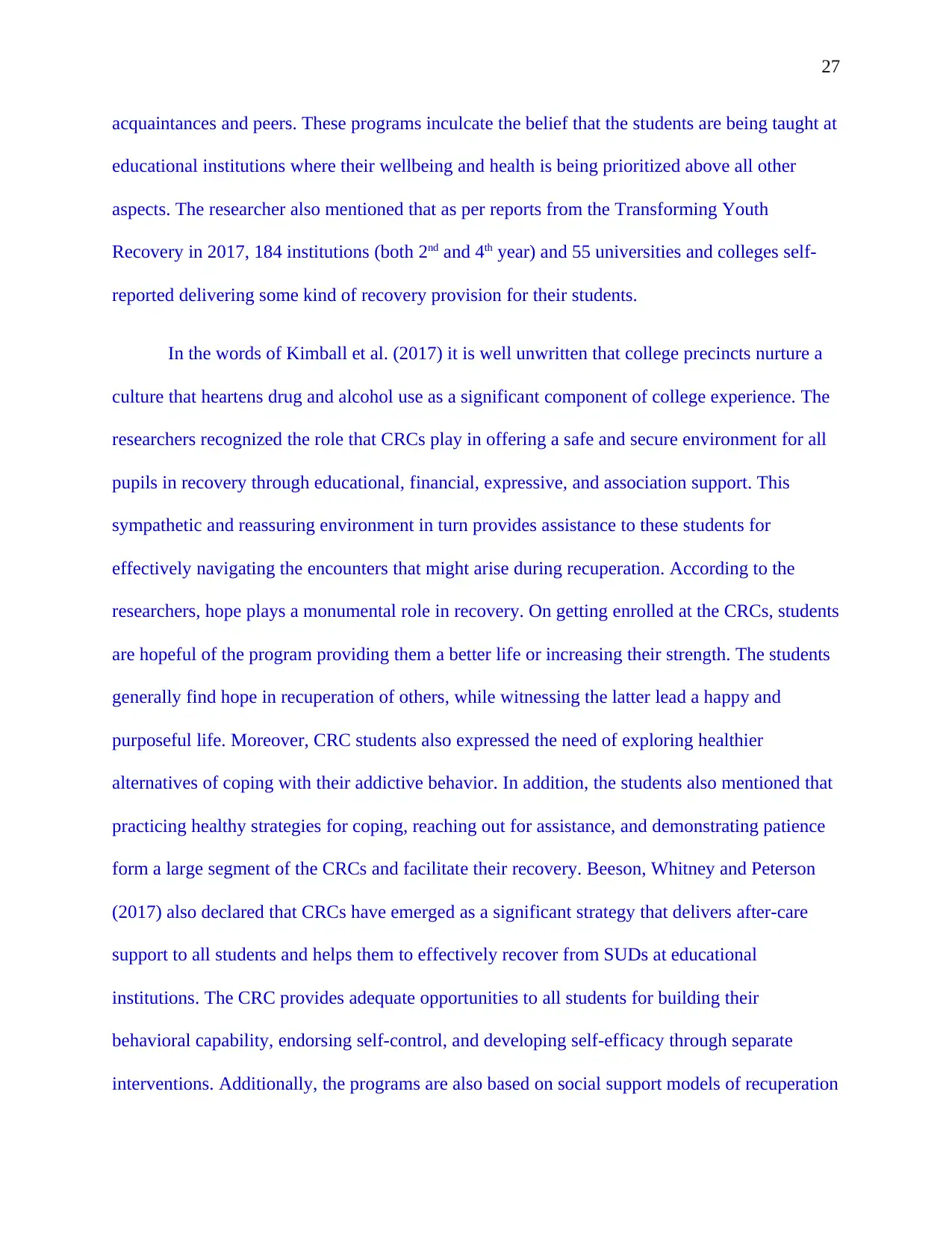
27
acquaintances and peers. These programs inculcate the belief that the students are being taught at
educational institutions where their wellbeing and health is being prioritized above all other
aspects. The researcher also mentioned that as per reports from the Transforming Youth
Recovery in 2017, 184 institutions (both 2nd and 4th year) and 55 universities and colleges self-
reported delivering some kind of recovery provision for their students.
In the words of Kimball et al. (2017) it is well unwritten that college precincts nurture a
culture that heartens drug and alcohol use as a significant component of college experience. The
researchers recognized the role that CRCs play in offering a safe and secure environment for all
pupils in recovery through educational, financial, expressive, and association support. This
sympathetic and reassuring environment in turn provides assistance to these students for
effectively navigating the encounters that might arise during recuperation. According to the
researchers, hope plays a monumental role in recovery. On getting enrolled at the CRCs, students
are hopeful of the program providing them a better life or increasing their strength. The students
generally find hope in recuperation of others, while witnessing the latter lead a happy and
purposeful life. Moreover, CRC students also expressed the need of exploring healthier
alternatives of coping with their addictive behavior. In addition, the students also mentioned that
practicing healthy strategies for coping, reaching out for assistance, and demonstrating patience
form a large segment of the CRCs and facilitate their recovery. Beeson, Whitney and Peterson
(2017) also declared that CRCs have emerged as a significant strategy that delivers after-care
support to all students and helps them to effectively recover from SUDs at educational
institutions. The CRC provides adequate opportunities to all students for building their
behavioral capability, endorsing self-control, and developing self-efficacy through separate
interventions. Additionally, the programs are also based on social support models of recuperation
acquaintances and peers. These programs inculcate the belief that the students are being taught at
educational institutions where their wellbeing and health is being prioritized above all other
aspects. The researcher also mentioned that as per reports from the Transforming Youth
Recovery in 2017, 184 institutions (both 2nd and 4th year) and 55 universities and colleges self-
reported delivering some kind of recovery provision for their students.
In the words of Kimball et al. (2017) it is well unwritten that college precincts nurture a
culture that heartens drug and alcohol use as a significant component of college experience. The
researchers recognized the role that CRCs play in offering a safe and secure environment for all
pupils in recovery through educational, financial, expressive, and association support. This
sympathetic and reassuring environment in turn provides assistance to these students for
effectively navigating the encounters that might arise during recuperation. According to the
researchers, hope plays a monumental role in recovery. On getting enrolled at the CRCs, students
are hopeful of the program providing them a better life or increasing their strength. The students
generally find hope in recuperation of others, while witnessing the latter lead a happy and
purposeful life. Moreover, CRC students also expressed the need of exploring healthier
alternatives of coping with their addictive behavior. In addition, the students also mentioned that
practicing healthy strategies for coping, reaching out for assistance, and demonstrating patience
form a large segment of the CRCs and facilitate their recovery. Beeson, Whitney and Peterson
(2017) also declared that CRCs have emerged as a significant strategy that delivers after-care
support to all students and helps them to effectively recover from SUDs at educational
institutions. The CRC provides adequate opportunities to all students for building their
behavioral capability, endorsing self-control, and developing self-efficacy through separate
interventions. Additionally, the programs are also based on social support models of recuperation
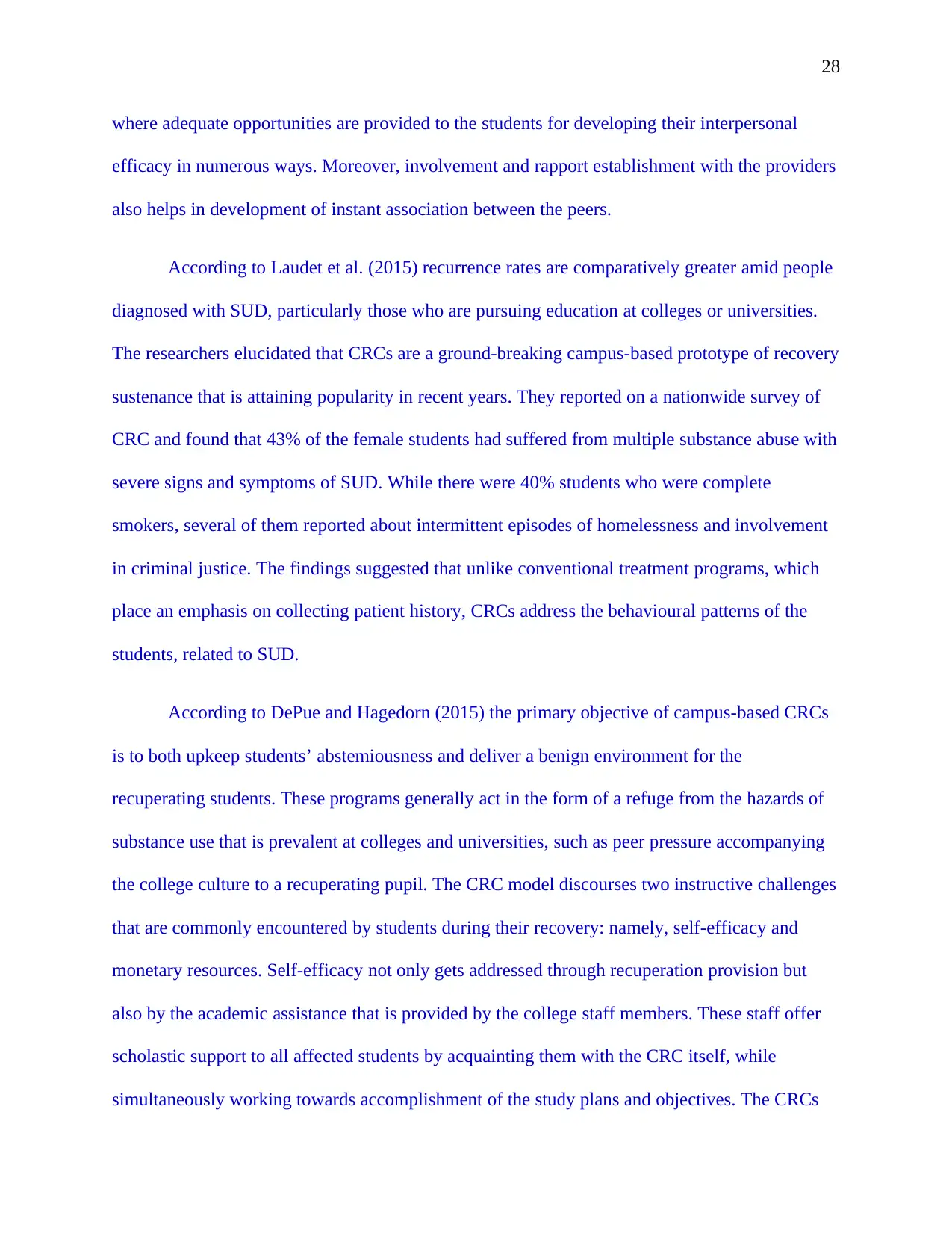
28
where adequate opportunities are provided to the students for developing their interpersonal
efficacy in numerous ways. Moreover, involvement and rapport establishment with the providers
also helps in development of instant association between the peers.
According to Laudet et al. (2015) recurrence rates are comparatively greater amid people
diagnosed with SUD, particularly those who are pursuing education at colleges or universities.
The researchers elucidated that CRCs are a ground-breaking campus-based prototype of recovery
sustenance that is attaining popularity in recent years. They reported on a nationwide survey of
CRC and found that 43% of the female students had suffered from multiple substance abuse with
severe signs and symptoms of SUD. While there were 40% students who were complete
smokers, several of them reported about intermittent episodes of homelessness and involvement
in criminal justice. The findings suggested that unlike conventional treatment programs, which
place an emphasis on collecting patient history, CRCs address the behavioural patterns of the
students, related to SUD.
According to DePue and Hagedorn (2015) the primary objective of campus-based CRCs
is to both upkeep students’ abstemiousness and deliver a benign environment for the
recuperating students. These programs generally act in the form of a refuge from the hazards of
substance use that is prevalent at colleges and universities, such as peer pressure accompanying
the college culture to a recuperating pupil. The CRC model discourses two instructive challenges
that are commonly encountered by students during their recovery: namely, self-efficacy and
monetary resources. Self-efficacy not only gets addressed through recuperation provision but
also by the academic assistance that is provided by the college staff members. These staff offer
scholastic support to all affected students by acquainting them with the CRC itself, while
simultaneously working towards accomplishment of the study plans and objectives. The CRCs
where adequate opportunities are provided to the students for developing their interpersonal
efficacy in numerous ways. Moreover, involvement and rapport establishment with the providers
also helps in development of instant association between the peers.
According to Laudet et al. (2015) recurrence rates are comparatively greater amid people
diagnosed with SUD, particularly those who are pursuing education at colleges or universities.
The researchers elucidated that CRCs are a ground-breaking campus-based prototype of recovery
sustenance that is attaining popularity in recent years. They reported on a nationwide survey of
CRC and found that 43% of the female students had suffered from multiple substance abuse with
severe signs and symptoms of SUD. While there were 40% students who were complete
smokers, several of them reported about intermittent episodes of homelessness and involvement
in criminal justice. The findings suggested that unlike conventional treatment programs, which
place an emphasis on collecting patient history, CRCs address the behavioural patterns of the
students, related to SUD.
According to DePue and Hagedorn (2015) the primary objective of campus-based CRCs
is to both upkeep students’ abstemiousness and deliver a benign environment for the
recuperating students. These programs generally act in the form of a refuge from the hazards of
substance use that is prevalent at colleges and universities, such as peer pressure accompanying
the college culture to a recuperating pupil. The CRC model discourses two instructive challenges
that are commonly encountered by students during their recovery: namely, self-efficacy and
monetary resources. Self-efficacy not only gets addressed through recuperation provision but
also by the academic assistance that is provided by the college staff members. These staff offer
scholastic support to all affected students by acquainting them with the CRC itself, while
simultaneously working towards accomplishment of the study plans and objectives. The CRCs
Secure Best Marks with AI Grader
Need help grading? Try our AI Grader for instant feedback on your assignments.
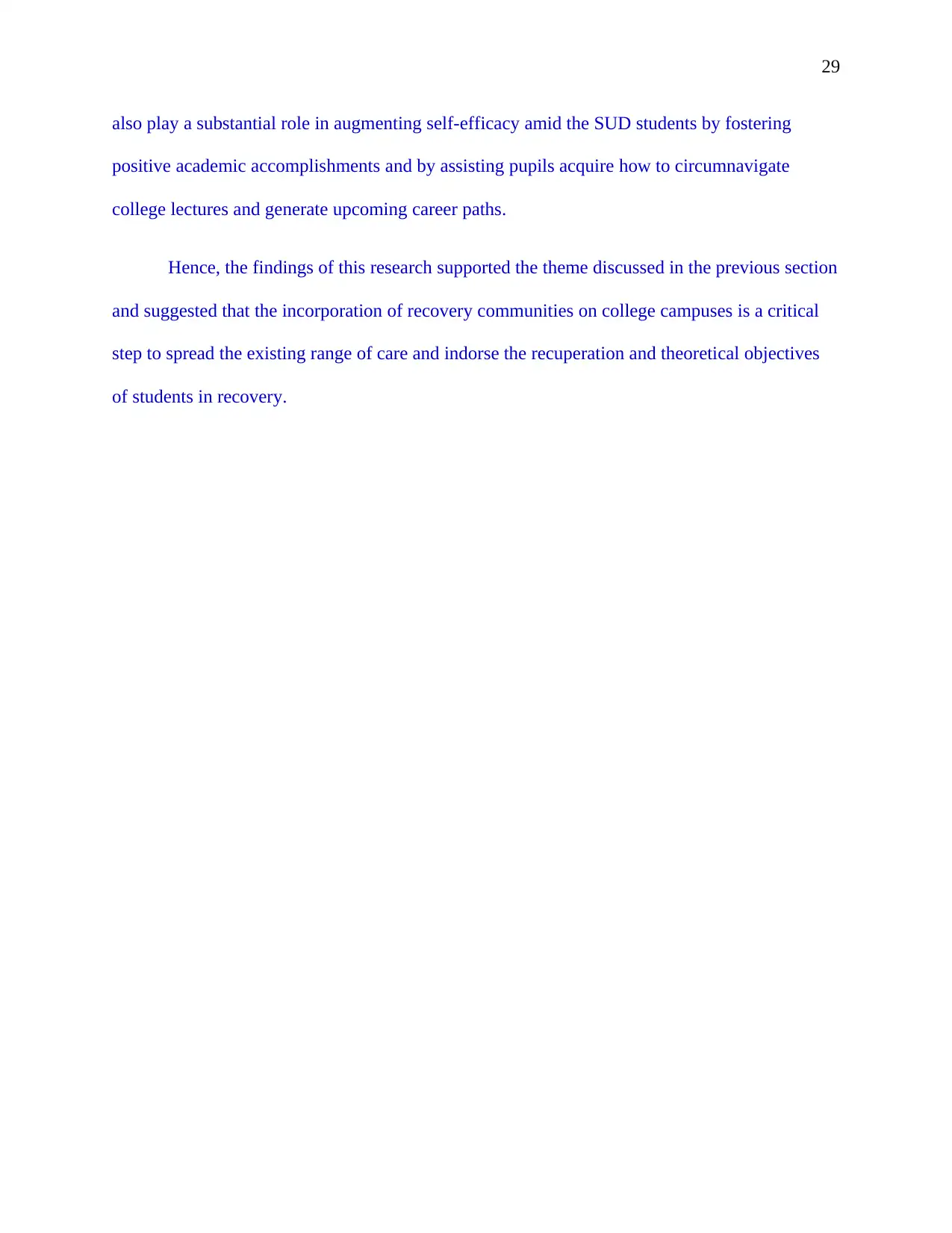
29
also play a substantial role in augmenting self-efficacy amid the SUD students by fostering
positive academic accomplishments and by assisting pupils acquire how to circumnavigate
college lectures and generate upcoming career paths.
Hence, the findings of this research supported the theme discussed in the previous section
and suggested that the incorporation of recovery communities on college campuses is a critical
step to spread the existing range of care and indorse the recuperation and theoretical objectives
of students in recovery.
also play a substantial role in augmenting self-efficacy amid the SUD students by fostering
positive academic accomplishments and by assisting pupils acquire how to circumnavigate
college lectures and generate upcoming career paths.
Hence, the findings of this research supported the theme discussed in the previous section
and suggested that the incorporation of recovery communities on college campuses is a critical
step to spread the existing range of care and indorse the recuperation and theoretical objectives
of students in recovery.
1 out of 29
Related Documents
Your All-in-One AI-Powered Toolkit for Academic Success.
+13062052269
info@desklib.com
Available 24*7 on WhatsApp / Email
![[object Object]](/_next/static/media/star-bottom.7253800d.svg)
Unlock your academic potential
© 2024 | Zucol Services PVT LTD | All rights reserved.




